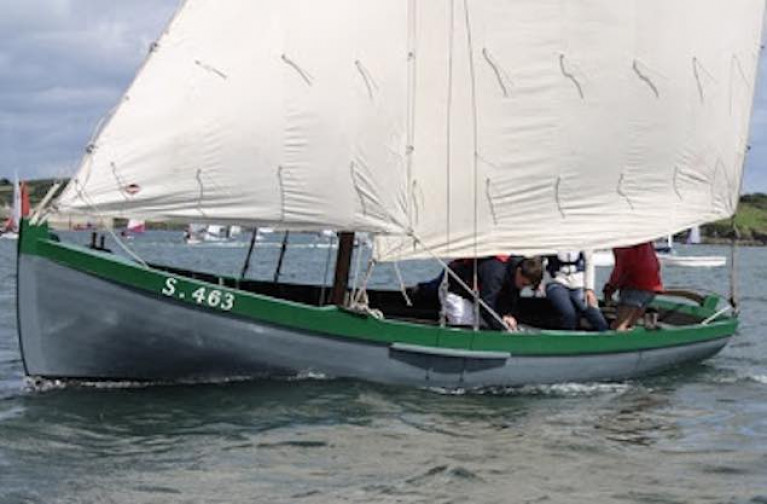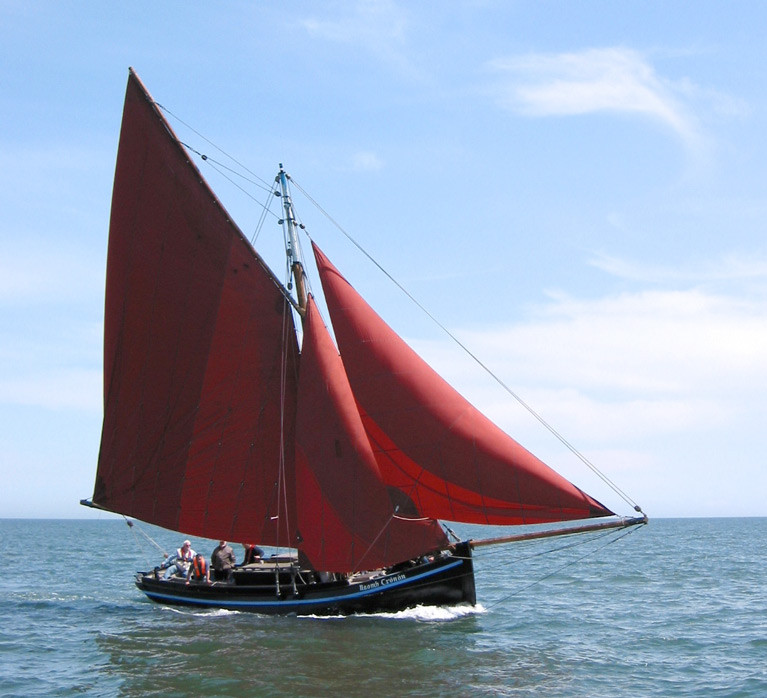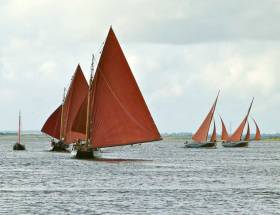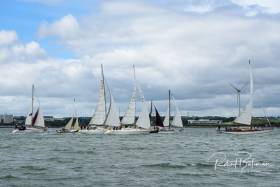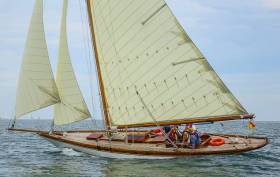Displaying items by tag: traditional boat
Dr Mick Brogan is very much at home in the west of Ireland, with his life as a country GP in Mayo neatly balancing his life as a traditional boat sailor, home-ported in Kinvara. In fact, he is so much a man of the west that he becomes restless if he spends any significant time east of the Shannon.
But between the day job and the leisure time interests, there was plenty to keep him occupied along the Atlantic seaboard, and though he had retired from medicine, he was very soon back in harness, re-joining the strength for the battle with COVID-19.
In that capacity, he found his interests over-lapping, as he is Chairman of Cruinniu na mBad in Kinvara. It was way back in early May, when he and his Committee crisply cancelled the mid-August 2020 Gathering of the Boats – always an epic party - that many of us properly realized, for the first time, how anything in sailing that had serious socializing at its core was off the agenda for the foreseeable future.
 Dangerously sociable for pandemic times – communal unloading of the turf at Kinvara after it has been raced in time-honoured style across Galway Bay from Connemara
Dangerously sociable for pandemic times – communal unloading of the turf at Kinvara after it has been raced in time-honoured style across Galway Bay from Connemara
The fate of Cruinniu na mBad 2021 is still in the lap of the Roll-out Gods, though if it does happen it will be August 13th to 15th. But meanwhile, Dublin Bay Old Gaffers Association have signed up Mick Brogan to Zoom talk on Thursday, March 11th about the new life which has been found for the Galway Hookers and other traditional western craft through restoration or re-building projects.
It's a subject in which he has special expertise, as his own vessel, the much-travelled 45ft 6ins Mac Duach, was designed and built on totally traditional lines by Colm Mulkerrins in Connemara in 1979. Originally, she was cutter rigged with an enormous widow-maker of a main boom, but these days she sets a more sedate ketch rig, yet still sails many miles.
 The mighty Mac Duach, built in 1979. Originally she was cutter-rigged, and it was under that rig that Mick Brogan sailed her to the Faroes and many other distant places
The mighty Mac Duach, built in 1979. Originally she was cutter-rigged, and it was under that rig that Mick Brogan sailed her to the Faroes and many other distant places
Mick Brogan's talk at 200hrs on Thursday, March 11th will to some extent following on from Dennis Aylmer's talk on his acquisition of the Galway Hooker Morning Star in 1966. Mick for his part will chart the early revival of interest in the Galway Hooker during the 1970s and 1980s, following its decline during the previous seventy years.
By the 1960s, there no hookers working under sail north of Slyne Head. The Saint John, Inishbofin's mailboat, was under engine. The "Westport" hookers of Achill and Clew Bay were no more. In south Connemara, lorries and improved roads had replaced hookers after WW2.
Ten years later, the introduction of bottled gas and electricity to Aran was killing the turf trade. Hookers were going the way of the horse and cart, but despite all the odds, a revival of interest in the hooker took place. Mick will describe this revival, identify the factors that caused it, and provide details of the people and the hookers involved.
 The spirit of the west – a rejuvenated Connemara Hooker making good speed to Kinvara against the distinctive background of The Burren
The spirit of the west – a rejuvenated Connemara Hooker making good speed to Kinvara against the distinctive background of The Burren
DBOGA Fundraising for HOWTH RNLI: Pre-Covid, DBOGA listened to talks together at Poolbeg while passing the RNLI Yellow Welly around for the €5 donation. In Zoom Land, they can't do that but the RNLI needs funds. Please click here
DBOGA have so far collected €2,399 against their target of €4,000.
The details of this Zoom meeting are:
- Topic: Mick Brogan Talk
- Time: March 11th 2021 at 20.00hrs
- Link to join the meeting: https://us02web.zoom.us/j/87256537027
- Meeting ID: 872 5653 7027
- Passcode: 704478
West Cork Traditional Boat Sets the Style on America's Great Lakes
You can take the boy out of West Cork, but you can't take West Cork - and its boats and sailing - out of the boy. That's especially so if he's one of the O'Keeffes, whose great names in sailing - such as Paddy O'Keeffe of Bantry and Maurice O'Keeffe of Schull - live on afloat through present generations, and in the restored and much-loved classics which they sailed in their day.
An intriguing example of the "Reach of the O'Keeffes" is Don O'Keeffe of the Schull branch. He may have fetched up in Wisconsin in the American Midwest, but by so doing and making a successful career there since 1987 in motor-yacht design, he reminds us that not only are the Great Lakes much more extensive than many of the salty seas that most of the rest of us so proudly sail, but his home port of Manitowoc has also been the setting – since 1968 – of the Wisconsin Maritime Museum, an institution which has steadily developed and expanded to put anything comparable in Ireland very much in the shade.
The quality of the WMM's dynamic interaction with the local community and the world beyond is well illustrated in this museum-produced video of a project that Don O'Keeffe recently brought to completion:
It tells us a lot, and very eloquently too, for Don has a lovely way with words. But for those who seek even more background, his 25ft 6ins Heir Island Lobster Boat Fiona is based on the lines – taken off by the Traditional Boats of Ireland Project – of the 1893-built Hanorah, which was re-built in 2003 in Oldcourt as part of a course run by owner Nigel Towse of Sherkin Island, and master boatbuilder Liam Hegarty.
 The traditional lines of Hanorah have been replicated in Don O'Keeffe's new boat Fiona in Wisconsin. Plans: Traditional Boats of Ireland
The traditional lines of Hanorah have been replicated in Don O'Keeffe's new boat Fiona in Wisconsin. Plans: Traditional Boats of Ireland
 Hanorah (left) and new-build sister-ship Saoirse Muirreann (Cormac Levis) in perfect summer sailing conditions off Sherkin Island. Photo: Robby Murphy
Hanorah (left) and new-build sister-ship Saoirse Muirreann (Cormac Levis) in perfect summer sailing conditions off Sherkin Island. Photo: Robby Murphy
In recent years we've had two links to Don O'Keeffe, as this most recent Wisconsin project came to us through Simon O'Keeffe of Schull, Don's nephew, who currently has a project under way with Tiernan Roe of Ballydehob to restore the famous gaff cutter Lady Min, which Simon's great grandfather Maurice O'Keeffe designed and built at Schull in 1902.
 The Lady Min – currently under restoration with Tiernan Roe of Ballydehob – was designed and built by Maurice O'Keeffe of Schull in 1902.
The Lady Min – currently under restoration with Tiernan Roe of Ballydehob – was designed and built by Maurice O'Keeffe of Schull in 1902.
But while Maurice O'Keeffe is now best known for his personal creation of the Lady Min 118 years ago, across the hills in Bantry Paddy O'Keeffe was linked to several notable boats, most notably the Albert Strange-designed yawl Sheila II which later was sailed to New Zealand in the 1950s, the handsome Robert Clark-designed 16-tonner John Dory, and designer-builder John B Kearney's own pet boat, the 1925-built 38ft yawl Mavis, which went to America in 1956.
We have of course been following the saga of the restoration of Mavis in Camden, Maine by Ron Hawkins. But while she finally sailed again in September of this year, when she was launched for the first time in her restored form back in 2015, as Ron Hawkins shepherded her down the harbour with a little outboard-driven tender alongside, at the helm of Mavis was Don O'Keeffe no less, keeping in touch with the boats of his youth and the special sailing to be found in West Cork.
 The newly-restored John B Kearney 1925 yawl Mavis – owned for some years by Paddy O'Keeffe of Bantry – is shepherd to her mooring in Camden, Maine by restorer Ron Hawkins, with Don O'Keeffe on the tiller.
The newly-restored John B Kearney 1925 yawl Mavis – owned for some years by Paddy O'Keeffe of Bantry – is shepherd to her mooring in Camden, Maine by restorer Ron Hawkins, with Don O'Keeffe on the tiller.
If you’re having trouble processing the full implications of the fascinating new portmanteau ministry which has emerged this week from the formation of our latest government, not to worry. You’d be on your own if you weren’t a little bit bewildered. But as it happens, sailing folk can be of good cheer. When we look at it calmly, there’s good reason to believe that it was all put together in order to meet the needs and achievements of one of the best-known boats in Ireland, the Clondalkin community-built 43ft Galway hooker Naomh Cronan, a classic bad mor or big boat.
Naomh Cronan is in the news this week in any case. After 23 years of great sailing, good racing and some impressive voyaging from Poolbeg in Dublin Port, it’s the end of an era. She has joined the western trek of traditional craft, and is now within the remit of Badoiri an Cladaig, - the Claddagh Boatmen - in their traditional base at the mouth of the River Corrib in the heart of Galway City.
In that picturesque harbour, there used to be a huge fleet of traditional tanned-sail craft at a time when Clondalkin was still mostly just fine farming country, the only nautical connection being the Grand Canal heading west through meadowland from Dublin Bay towards the River Barrow and the lordly Shannon.
 Traditional sail at The Claddagh, home of Badoiri an Cladaigh. This is Ross Forde’s 25ft gleoiteog mor Lady Anne of 1882 vintage sailing into the Corrib - she is used by the Galway Hooker Sailing Club as a sail training vessel
Traditional sail at The Claddagh, home of Badoiri an Cladaigh. This is Ross Forde’s 25ft gleoiteog mor Lady Anne of 1882 vintage sailing into the Corrib - she is used by the Galway Hooker Sailing Club as a sail training vessel
So that’s fine and dandy, say you, but what’s this about the new do-everything Department apparently being specifically assembled to meet the historical and present and future needs of the Naomh Cronan? Well, it’s all here in the fresh-minted Department’s title. And we ask our many overseas readers to bear with us, but this really is the name of the Hydra-headed administrative machine which has emerged from the undergrowth of political backroom wheeler-dealing in recent days.
It’s called the Department of Media, Tourism, Arts, Culture, Sport and The Gaeltacht. Seriously. In one of the most sports-mad nations on earth, the greatest passion of the majority of the population seems to be ranked fifth in priority in a wide selection of interests and specialities each of which might well - in a more detailed society - be worth a Department of its own, though we would concede that maybe Arts & Culture might go together in one.
 Carrying the message – Naomh Cronan at Portaferry for the Sails & Sounds Festival
Carrying the message – Naomh Cronan at Portaferry for the Sails & Sounds Festival New waters – Naomh Cronan on Strangford Lough
New waters – Naomh Cronan on Strangford Lough
But in any case, all is not as it initially seemed a few days ago, when the new setup was first announced. For as it happens, it may actually be three Departments in one. When the new conglomerate was revealed at the beginning of the week, it had just one Minister, who is a senior member of the Cabinet. But when the supporting Ministers of State were announced later in the week, two of them were allocated areas of interest across the new Department, which made it a much more positive and potentially productive arrangement.
But how on earth is it that this complex new multi-functional department seems to have been created precisely with the story of the Naomh Cronan in mind? Let us count the ways:
MEDIA: Check. Ever since her construction started as a project inaugurated by Muintir Chronain under the auspices of Aras Chronain Ionad Cultuir (the Irish Cultural Centre in Clondalkin, West Dublin) all of 27 years ago, Naomh Cronan has been an item of media interest ashore and afloat, her creation and vibrant existence being of interest both in themselves, and as an exercise for trainee communicators and other media wannabees.
TOURISM: Check. The evocative dark and distinctive sails of the Galway hookers slipping through the myriad waterways of Connemara and Galway Bay may be the ultimate iconic and eternally-remembered vision for visitors to the west - to l’Irelande profonde - yet from her East Coast base of 23 years, the Naomh Cronan has managed to become an Irish eastern ambassador with a western flavour at traditional sailing festivals in Scotland, the Isle of Man, Wales, England, Brest and Douarnenez in France, and all along the east and south coasts of Ireland too, from Belfast Lough to Glandore.
 Naomh Cronan at the Festival of Traditional Sail at Peel in the Isle of Man. Photo: W M Nixon
Naomh Cronan at the Festival of Traditional Sail at Peel in the Isle of Man. Photo: W M Nixon
 Joe Pennington’s restored Manx fishing cutter Master Frank and the Naomh Cronan racing for the DBOGA’s Leinster Trophy in Dublin Bay. Photo: Dave Owens
Joe Pennington’s restored Manx fishing cutter Master Frank and the Naomh Cronan racing for the DBOGA’s Leinster Trophy in Dublin Bay. Photo: Dave Owens
ARTS: Check. Naomh Cronan was an inspiration for painters and sculptors even before she went afloat, and under sail she has become a continuous source of fresh creative ideas. She brings music with her wherever she goes, indeed for many she is a floating moving symbol of Irish music and dance.
CULTURE: Check. Naomh Cronan could be nothing else except a quintessentially Irish boat telling us what we are and who we are, with the natural expressiveness, creativity, camaraderie and co-operation of her builders and crew translating effortlessly into action as needed, without undue fuss or superfluous seriousness.
SPORT: Check, and check again with emphasis. Racing a bad mor of the Galway Hooker tradition is not a sport for the faint-hearted. Yet although the hottest competition of the traditional boats is to be found in Connemara with stripped-out racing machines, even the Naomh Cronan with her cabin and sea-going accommodation can give a good showing of herself. She was has won several trophies over the year, a particularly memorable performance being put in at the annual Howth Lambay Race of 2013 when – with Paddy Murphy of Renvyle in West Galway, a one-man Irish dance troupe, guesting as helm – Naomh Cronan took second in the classics division despite much more modern-type boats in the competition.
 Shaping up for a bit of sport – former DBOGA President Dennis Aylmer’s “plastic classic” Mona and Naomh Cronan in pre-start manoeuvres in Scotsman’s Bay off Dun Laoghaire: Photo: Dave Owens
Shaping up for a bit of sport – former DBOGA President Dennis Aylmer’s “plastic classic” Mona and Naomh Cronan in pre-start manoeuvres in Scotsman’s Bay off Dun Laoghaire: Photo: Dave Owens
THE GAELTACHT: Check. The Irish-speaking areas in their time-honoured and usually scenic locations may be most readily associated with Gaeltacht ways and language, but in West Dublin people really have to work at it to build up and maintain a living tradition. In Clondalkin and the area around it, they’ve achieved a remarkable level of success in Gaeltacht projects with much use of the language, with the Naomh Cronan being one of its symbols.
There you have it. All the boxes are well and truly ticked. So how is it that this ultimate expression of a fine ideal has now taken her departure from a community and an area and a port where she meant so much?
Well, life moves on. The situation that made Naomh Cronan fit in so well in her times has now changed. When she was built, there were several restored Galway Hookers of the bad mor type based on the East Coast, and their racing at places like Poolbeg and Portaferry and Howth was simply tremendous.
However, maintaining such boats is labour intensive - and hard labour at that - and key people got older. But perhaps most crucially of all, the Dublin to Galway motorway opened, the magic road to the west, so magic that it made it possible for people from Clondalkin and other places in west Dublin to get to the “true” hooker sailing areas on the Atlantic seaboard almost as quickly – and certainly with much less traffic hassle – than they would experience in getting to harbours in the Greater Dublin area.
 Joe Murphy of the renowned Ringsend boat-building family drew the plans for Naomh Cronan in 1993. Photo courtesy Cormac Lowth
Joe Murphy of the renowned Ringsend boat-building family drew the plans for Naomh Cronan in 1993. Photo courtesy Cormac Lowth
 Joe Murphy produced traditional plans with the boat levelled along the line of the keel, and the rudder markedly angled in the style of most contemporary hookers, but he left the design of the cabin top and accommodation to the building team. Courtesy Cormac Lowth
Joe Murphy produced traditional plans with the boat levelled along the line of the keel, and the rudder markedly angled in the style of most contemporary hookers, but he left the design of the cabin top and accommodation to the building team. Courtesy Cormac Lowth
So it soon got to the stage that the only bad mor in commission on the east coast was the Naomh Cronan of the Dublin Bay Old Gaffers Association at the ever-hospitable Poolbeg Y&BC, to which her crew had a fierce loyalty. But as time went on, increasing prosperity mean that people who in times past would have sought their sailing on the Naomh Cronan began to think of having boats of their own. And sunshine cruising holidays, with charter boats in places like the Greek Isles, also came up on the agenda.
Thus while Naomh Cronan had been great for her times in Dublin, in Dublin, those times were irrevocably changing, whereas in the west a new dawn has ben rising for traditional boats. The opportunity for a neat transfer of Naomh Cronan’s ownership - or more properly her custodianship - from Clondalkin to the Claddagh was there to be taken at exactly the right time.
 People involved – Stiofan O Laoire, Paul Keogh, and Johnny Wedick of Naomh Cronan, Poolbeg Y&BC and DBOGA. Photo: Dave Owens
People involved – Stiofan O Laoire, Paul Keogh, and Johnny Wedick of Naomh Cronan, Poolbeg Y&BC and DBOGA. Photo: Dave Owens
But before looking to Naomh Cronan’s future now that she has become a welcome arrival in the west, we must acknowledge the enormous contribution made by those far-sighted and dedicated people who – 27 years ago – set about bringing this much-loved vessel into existence, and that at a time long before there seemed to be a government department entirely devoted to helping them fulfil the dream.
When Michael Heffernan and school headmaster Stiofan O Laoire and other key people in the Irish cultural movement in Clondalkin in West Dublin suggested to the likes of Gerry Keane and others in 1993 that Muintir na Chronain in their neighbourhood should add an extra focus to its activities by building a fully-fledged bad mor in the heart of their West Dublin community, it was something of a leap into the unknown. And that can be seen in this As Gaeilge 1996 RTE vid of the building underway, interviewing Michael Heffernan – even if you don’t have the cupla focal, it’s worth watching for the atmospherics alone here
For sure, the population of Clondalkin includes many talented carpenters and other craftsmen whose skills could be re-directed into such a project. But with this ultra-traditional type of boat, there were those who said that building such a craft needed to be done in a place with a long boat-building tradition. And notwithstanding the Grand Canal going through it, and the River Liffey not so very distant, Clondalkin as a boat-building centre didn’t tick any boxes at all..
 A traditional boat takes shape in the heart of Clondalkin – Naomh Cronan in frame in 1995. Photo: Brian O Gaibhin
A traditional boat takes shape in the heart of Clondalkin – Naomh Cronan in frame in 1995. Photo: Brian O Gaibhin
But they persisted, and were given a boost by the late Joe Murphy of the renowned Ringsend boat-building family, who created a set of hull lines and building details of the standard hookers as they are today. They make for a fascinating comparison with the line drawings which were published by naval architect Dixon Kemp as taken off a champion hooker in 1891. For in 1891, the rudder was less radically raked than it is today, a continuing development which one might have thought has impaired the boat’s steering characteristics.
But as those who know the very small harbours of Connemara have pointed out, in their heartlands the hookers have to dry out in ports with only very small areas of clear sand between rock. Thus for the boats to dry out in comfort at low water, the shorter the keel can be made relative to the boat’s size, the better, for it means you get more boat for your confined berth thanks to the increasing tendency over the years to give the rudders this ferocious rake with the shortest possible length of keel.
 Some of the work was more easily done with the boat canted. The coachroof and accommodation were designed by the building team. Photo: Brian O Gaibhin
Some of the work was more easily done with the boat canted. The coachroof and accommodation were designed by the building team. Photo: Brian O Gaibhin
Joe Murphy designed the hull and rig with some lovely drawings, but it was left to the folk in Clondalkin to shape their own coachroof and the accommodation they required. In those days, computer-generated imaging was still in its infancy, and the three-dimensional design challenge to provide the optimal accommodation was best done with work in progress.
It was such a clearly-defined and almost exotic project, with something to show for their efforts almost as soon as work had begun, that the building of the Naomh Cronan (she was named for the neighbourhood saint from the time of Ireland being “The Island of Saints & Scholars”) seemed to acquire its own momentum, with useful advice readily forthcoming from the many – experienced boatmen and boatbuilders among them – who wished the project well.
 Massive timbers of the foc’s’le framing. Photo: Brian O Gaibhain
Massive timbers of the foc’s’le framing. Photo: Brian O Gaibhain
 When things were going well and completion was in sight, the building of Naomh Cronan was a good-humoured affair. Photo: Brian O Gaibhain
When things were going well and completion was in sight, the building of Naomh Cronan was a good-humoured affair. Photo: Brian O Gaibhain
Admittedly it took four years to complete the build, but by this time the shared experience had created such a dedicated and friendly team within the cultural community within its own larger community, that it was almost with sadness they realized the building experience was nearing completion.
Soon, the big boat would be taken away to Dublin docks for launching, and though it was expected that in some winters she’d be back for maintenance work in her birthplace in Clondalkin, the focus inevitably was shifting elsewhere, and quite where and what that elsewhere would be was anyone’s guess.
 At last – the Naomh Cronan emerges new-built from her shed. Photo: Brian O Gaibhin
At last – the Naomh Cronan emerges new-built from her shed. Photo: Brian O Gaibhin
 The first taste of saltwater in Dublin Port in 1997. Photo: Brian O Gaibhin
The first taste of saltwater in Dublin Port in 1997. Photo: Brian O Gaibhin
But basically, the focus afloat from 1997 became Poolbeg, where a highly visible mooring in the River Liffey right beside the busy road to the Eastlink Bridge kept Naomh Cronan in the public eye, while her increasing appearance at sailing festivals near and far provided celebrity status all along the Celtic fringe, with useful experience-enhancing offshore sailing experience in between.
This busy sailing programme had come about through Paul Keogh, an energetic, focused and affable young man who joined the building team in the final year or two of construction and then proved the ideal person to become Naomh Cronan’s skipper, sailing manager and general keeper-of-the-show-on-the-road.
He has been in a leading role ever since, with Naomh Cronan actively sailed for 23 years. But he is nothing if not a realist, and by the time 2020 was upon us, he and other key figures were accepting that Naomh Cronan was reaching the stage that she needed major work to be done, and they had to look seriously at the expressions of interest from the Claddagh boatmen.
 A long way from a dusty shed and a demanding boat-building schedule – Naomh Cronan sailing on a perfect summer’s day. Photo: W M Nixon
A long way from a dusty shed and a demanding boat-building schedule – Naomh Cronan sailing on a perfect summer’s day. Photo: W M Nixon
A central role in the changeover was filled by Donal Greene, a boatbuilder from Carna in Connemara who teaches woodwork in a school in Meath, and almost as a sideline is a genius with qualifications in computer work. The Naomh Cronan had discovered this when their big mast needed replacing, and Donal produced drawings and then did the new-build work to international standards.
 The boatbuilder from Carna – shipwright Donal Greene is a man of many talents. Photo: Cormac Lowth
The boatbuilder from Carna – shipwright Donal Greene is a man of many talents. Photo: Cormac Lowth
 Built with precision – the new mast created by Donal Greene. Photo: Brian O Gaibhain
Built with precision – the new mast created by Donal Greene. Photo: Brian O Gaibhain
 Classic belaying pins for the new mast. Photo: Brian O Gaibhain
Classic belaying pins for the new mast. Photo: Brian O Gaibhain The new planking fitted on Naomh Cronan by Donal Greene in this Spring’s good weather. Photo: Cormac Lowth
The new planking fitted on Naomh Cronan by Donal Greene in this Spring’s good weather. Photo: Cormac Lowth
With this link to the West and a high availability of talent in the COVID-19 shutdown, Donal Greene was able to provide Naomh Cronan with a major re-planking job in Malahide shipyard in the healthiest possible open-air conditions during that exceptional period of dry weather which mocked the rest of us in April and May. And with full survey requirements complied with, the easing of Lockdown last weekend saw Peter Connolly and Peter Carpenter of Badoiri an Cladaigh travel to Malahide for an inspection and a formal meeting with the Naomh Cronan team, followed by the signing of documents which saw the much-loved vessel transferred to the custodianship of the Claddagh Boatmen for the princely sum of €100.
 At the signing over of the Naomh Cronan at Malahide last weekend were (left to right) John Wedick (DBOGA), Peter Redmond (DBOGA), Peter Carpenter (Badoiri an Cladaigh), Brian O Gabhain (Aras Chronain Clondalkin), Peter Connolly (Badoiri an Cladaigh), Negley Groome (DBOGA), Gerry Keane (Naomh Cronan & DBOGA), John Elston (Naomh Cronan & DBOGA), Paul Keogh (Naomh Cronan & DBOGA), Mark Sweetnam (DBOGA), Cormac Lowth (Naomh Cronan & DBOGA) and Donal Greene (Naomh Cronan & Badoiri an Cladaigh & DBOGA). Photo courtesy Cormac Lowth.
At the signing over of the Naomh Cronan at Malahide last weekend were (left to right) John Wedick (DBOGA), Peter Redmond (DBOGA), Peter Carpenter (Badoiri an Cladaigh), Brian O Gabhain (Aras Chronain Clondalkin), Peter Connolly (Badoiri an Cladaigh), Negley Groome (DBOGA), Gerry Keane (Naomh Cronan & DBOGA), John Elston (Naomh Cronan & DBOGA), Paul Keogh (Naomh Cronan & DBOGA), Mark Sweetnam (DBOGA), Cormac Lowth (Naomh Cronan & DBOGA) and Donal Greene (Naomh Cronan & Badoiri an Cladaigh & DBOGA). Photo courtesy Cormac Lowth.
It will take a while for it all to sink in, but the process has been aided by efficient logistics ever since, with Kennedy Haulage’s majestic boat-moving low loader sweeping into Malahide Boatyard on Wednesday afternoon. Many of the Naomh Cronan Clondalkin team are accustomed to working with heavy equipment, but even they were impressed by the crisp way in which Malahide Boatyard and the Kennedy setup moved into smoothly co-ordinated action, which saw their beloved bad mor transformed into just another handy little load ready for easy movement westward.
By 4.0pm, it was a case of: “The dogs bark, but the caravan moves on”. Naomh Cronan was gone from Malahide, and soon gone from Dublin too, without a thought of sentimentally swinging by Poolbeg or through Clondalkin, gone west and comfortably into Oranmore at the head of Galway Bay that evening.
 Quick work. Naomh Cronan was smoothly in Oranmore by Wednesday evening. Photo: Pierce Purcell
Quick work. Naomh Cronan was smoothly in Oranmore by Wednesday evening. Photo: Pierce Purcell
Naomh Cronan was launched into the waters of the west at the quay at Galway Bay Sailing Club at Rinville on Thursday morning and had her mast stepped before the day was out. This weekend will see her being sorted while the new planking takes up, and then all being well on Tuesday she’ll sail across the upper reaches of Galway Bay and into The Claddagh to begin the latest chapter in a remarkable life story.
But meanwhile, her former sailors on the east coast won’t be at a loss for things to do around boats. While in Malahide working on the ship, Paul Keogh discovered that a hefty big sailing cruiser in the yard, fibreglass built and needing work done, but exuding character nevertheless, was very competitively for sale. Having done his duty and more with wooden construction and its maintenance in his many years with Naomh Cronan, he personally bought the boat in Malahide. For the foreseeable future, the Devil will not be finding work for idle hands.
However, the links with their former ship haven’t been broken entirely, with Paul Keogh and others becoming Trustees of Badoiri an Cladaig with a standing invitation to re-join their former ship at any time. Nevertheless, we are undoubtedly looking at the very clear end of an era.
 The new era. Naomh Cronan already rigged at Renville Quay at GBSC on Friday, with a weekend for sail fitting and other jobs planned, and then a sail across to The Claddagh on Tuesday. Photo: Pierce Purcell
The new era. Naomh Cronan already rigged at Renville Quay at GBSC on Friday, with a weekend for sail fitting and other jobs planned, and then a sail across to The Claddagh on Tuesday. Photo: Pierce Purcell
Are Traditional Boat Building Skills Disappearing?
Following the interest in last week’s Podcast on the question – Why Do We Own Boats – and the views on the topic expressed by Brother Anthony Keane of Glenstal Abbey, I’ve been intrigued by the number of people who contacted me since, referring to an ancillary issue about owning boats– maintaining and preserving them and difficulties in some areas of finding the necessary skills.
It seems problems are associated with the types of boats needing attention and whether all yards have the skills within their staffs or need to seek it from what appears to be a finite number of people with specialist skills and that shipwrights appear to be a disappearing trade.
I was even told that maritime archaeologists are becoming increasingly interested in working with boat builders to study traditional maritime skills, because of concern that they are disappearing.
There are areas where the skills are being passed on – such as the ILEN boat building school in Limerick and the Hegarty yard at Old Court near Skibbereen, where boat building skills are certainly evident in how the ILEN was reconstructed there. The Meitheal Mara community boatyard in Cork is another area of activity.
 The skills of a boatyard in evidence as restored Dublin Bay 21 Naneen is lowered into the water at Kilrush
The skills of a boatyard in evidence as restored Dublin Bay 21 Naneen is lowered into the water at Kilrush
There are courses in boat building offered at Third Level Institutes and voluntarily by sailing and boat clubs, but the passing on of skills and recruitment of apprentices does seem to be an issue. When there is a special boat project underway it can attract a lot of public attention which can feed into an awakening of interest in the skills. That point was made to me by Steve Morris who led the revival of the Dublin Bay 21 Naneen at Kilrush Boatyard in County Clare. When she was launched, he told me that the project would leave behind interest in the skills and referred to the problems which Afloat readers and Podcast listeners have identified.
Listen to Steve Morris on the Podcast below
After a week of thinking maybe too much about modern and ultra-modern boats contesting the Fastnet Race and Calves Week at Schull, it’s a comforting relaxation to settle gently into contemplation of this weekend’s annual Crunniu na mBad (The Gathering of the Boats) for traditional boats and Irish culture at Kinvara on the west coast, and the championship of the venerable Seventeen Footer class at Howth on the eastern seaboard writes W M Nixon.
Not that the racing, in either case, is a matter of comfortable relaxation. With the Howth Seventeens, it’s the quality of the sport that has kept them going since 1898, unchanged from their original jackyard-topsail-setting design. And with 18 boats in commission this year, the old class is truly fighting fit. That said, the way this weekend’s low pressure area has been behaving, the winds on the east coast have tended to be stronger than in the west, so the Seventeens cancelled their first race scheduled for last night, and start the competition this morning (Saturday).
 Summertime on the East Coast. The Howth Seventeens Isobel (Conor & Brian Turvey) and Leila (Roddy Cooper) beating into the sea breeze as they approach The Stack at the east point of the island of Ireland’s Eye off Howth. The stack is one of Ireland’s more recent gannetries – the first pair of gannets nested there in 1989, and now the colony is so strong it has spread to the nearby island despite the threat of rats, while a new sub-colony has been formed on a rock on the north side of Lambay six miles away. Photo: Tom Ryan
Summertime on the East Coast. The Howth Seventeens Isobel (Conor & Brian Turvey) and Leila (Roddy Cooper) beating into the sea breeze as they approach The Stack at the east point of the island of Ireland’s Eye off Howth. The stack is one of Ireland’s more recent gannetries – the first pair of gannets nested there in 1989, and now the colony is so strong it has spread to the nearby island despite the threat of rats, while a new sub-colony has been formed on a rock on the north side of Lambay six miles away. Photo: Tom Ryan
Cruinnui na mBad is a much more complex affair organised by Dr Mick Brogan and his team, an extraordinary interaction between sea and land which was started by the late Tony Moylan in 1979 – making this its 40th Anniversary – to commemorate and celebrate the fact that in times past, and particularly in August, the traditional Hookers of Connemara would sail right up Galway Bay and into the sweet natural harbour of Kinvara carrying turf.
Kinvara is at the heart of a relatively lush area which is very different from Connemara, and thus lacking in readily-available natural supplies of the traditional fuel. So the voyage there with a useful consignment of winter warmth had a natural harmony, and of course, the safe arrival and discharge of the cargo was something for celebration in the Pier Head bar and other hostelries in the popular little village by sailors and locals alike.
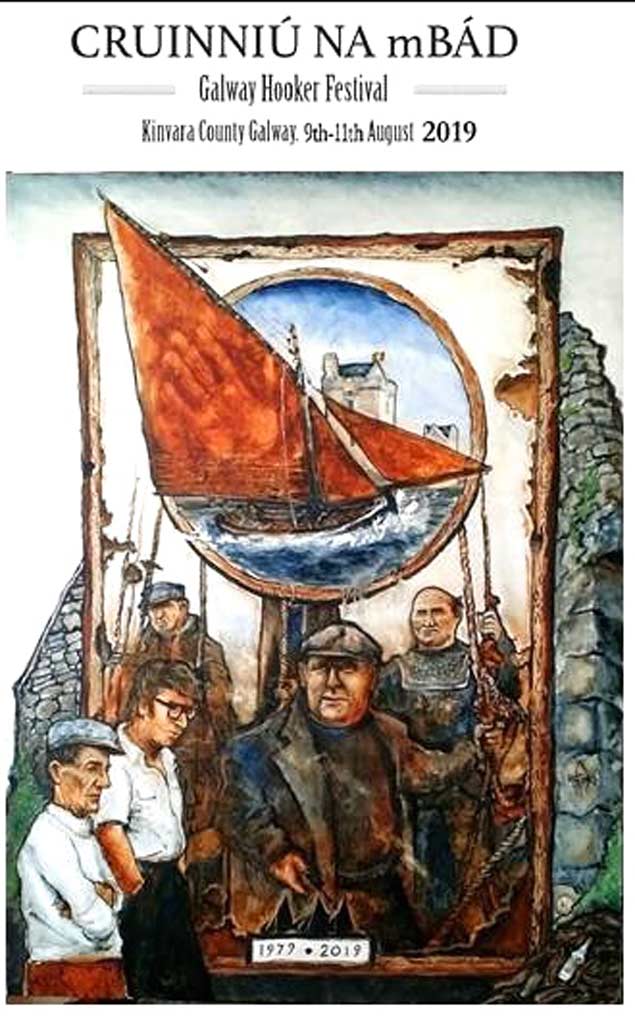 This weekend sees the fortieth annual Cruinnui na mBad – the late Tony Moylan (second left) was the main mover in founding it back in 1979
This weekend sees the fortieth annual Cruinnui na mBad – the late Tony Moylan (second left) was the main mover in founding it back in 1979
These days, the useful motorway from Dublin to Galway, plus the continuing strength of trad-boat enthusiasm in both Connemara and in Galway city itself, has seen a resurgence of life in the traditional sailing boats of the west. The convenience of the motorway means that any Galway hooker enthusiast living in the outskirts of the greater Dublin area can be with their special craft on Galway Bay as quickly as the boat could be reached at a Dun Laoghaire, Poolbeg or Howth harbour berth, and needless to say berthing charges in the west are a very different proposition – indeed, in some of the more picturesque places, the traditional boats should be paid appearance money…….
Certainly, it’s the massed appearance of the Galway Hookers in all sizes which is the making of the Kinvara festival, even if the music and dancing and singing and festivities seem to grow with every year. The time-honoured ceremony of discharging the turf cargo is completed on the quay in the heart of the village today at 4.0pm, while as the tide make towards high water the racing gets underway today at 2.30pm at Parkmore for the Gleoiteog Race, and for the bigger boats at 2.0 pm tomorrow (Sunday), starting and finishing almost in the heart of town.
 The Galway Hookers may be the historic representatives of an ancient type, but they are hard raced nevertheless. Photo: Paul Harris
The Galway Hookers may be the historic representatives of an ancient type, but they are hard raced nevertheless. Photo: Paul Harris
Last year in the four divisions, the winner of the Bad Mor (big boat) Class was the Tonai, skippered by Mairtin O’Brien, while the slightly smaller Leath Bad (half boat) class went to Croi na Cladaigh, built in 2012 in Galway city by Peter Connolly, and raced on the day by the legendary Colie Hernon.
John Flaherty sailing the Gleoitog Mor Naomh Cailin was the winner in that class, while the small boats of the Gleoitog division were led in by Colie og Hernon. All this was only part of the sport afloat, as the seaweed raft racing took place right in the harbour, and simply staying afloat was as important as winning.
 Tank-tested design for a seaweed raft……..Photo Pierce Purcell Jnr
Tank-tested design for a seaweed raft……..Photo Pierce Purcell Jnr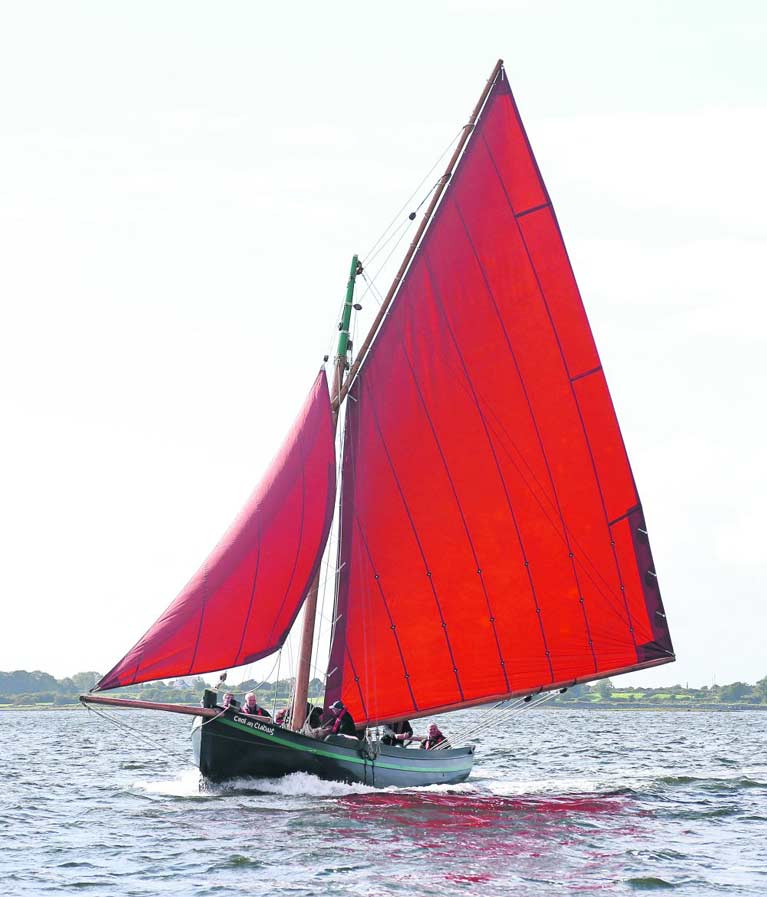 The leath bad Croi na Cladaig (Peter Connolly) was raced by Colie Hernon to the class win in 2018
The leath bad Croi na Cladaig (Peter Connolly) was raced by Colie Hernon to the class win in 2018
With this weekend’s volatile weather, several boats from Connemara had already made the prudent decision to get themselves to Kinvara before the current low-pressure system began to do its worst, and as of last night there were already nearly 30 of those classic hulls to be seen at the quay.
As it happens, the low-pressure area itself had filled a bit over the land, but as ever there always a vicious twist or two in the tail in the form of sudden squalls and maybe thunderstorms as the system re-gathers strength over the North Sea. But nevertheless the unusual situation has developed where there may be more wind on the east coast than in the west, so all being well the racing programme will be completed at Kinvara in a westerly today, and a moderate to fresh northwest to north breeze tomorrow
Whatever the outcome, the underlying trend in the Connacht traditional boat movement is healthy, and the latest piece of good news is that the famous True Light, after quietly decaying for a number of years, has been bought by a quartet of new owners, and they’re bringing her to Galway city itself for a complete restoration in the same place as the much-admired Gentle Ann was given new life.
 The timeless image of the west – boats of the Bad Mor class racing at Kinvara
The timeless image of the west – boats of the Bad Mor class racing at Kinvara
 High summer in Kinvara – Dungaire Castle in foreground, and the village itself beyond, with the hills and mountains of The Burren in the distance
High summer in Kinvara – Dungaire Castle in foreground, and the village itself beyond, with the hills and mountains of The Burren in the distance
With the Howth Seventeens all being based in the one harbour and most owners living almost within walking distance, the decision to cancel the first race last night was not a big deal. So for now we should enjoy some unusual photos of these little boats taken by Tom Ryan who - in addition to a day job - is Assistant Cox’n of Howth Lifeboat, and is also an amateur photographer (using the moniker Stormy Photos) who enjoys finding unusual shots out on his RIB or up on the cliffs in Howth.
It takes a fresh eye to remind us of what an odd and exotic place is the Howth Peninsula, for inevitably we sometimes tend to take it for granted, yet all these images were obtained within a couple of kilometres of where I’m sitting writing this.
 The Howth 17s in close formation – Aura (No 7, Ian Malcolm, foreground) has been winning in Dublin Bay, but the Masseys and Mikey Twomey in Deilginis (No 11, right) have been winning in home waters, while success has also been recorded by Brian and Conor Turvey in the silver-hulled Isobel (No 19), Peter Courtney in the yellow-hulled Oonagh (No 17), and John Curley and Marcus Lynch in the white-hulled Rita (No 1). Photo: Tom Ryan
The Howth 17s in close formation – Aura (No 7, Ian Malcolm, foreground) has been winning in Dublin Bay, but the Masseys and Mikey Twomey in Deilginis (No 11, right) have been winning in home waters, while success has also been recorded by Brian and Conor Turvey in the silver-hulled Isobel (No 19), Peter Courtney in the yellow-hulled Oonagh (No 17), and John Curley and Marcus Lynch in the white-hulled Rita (No 1). Photo: Tom Ryan
And as for the Howth Seventeens racing, the word is that Ian Malcolm with the 1898-built Aura has been winning when it involves going south of the Baily, as he topped the class in the VDLR19 Regatta in Dublin Bay and also won in the annual race to Clontarf for the recent Clontarf Y&BC “At Home”.
 Hugging the cliffs to beat the tide. As the Clontard Y&BC At Home is held in a tidal venue, the Howth 17s have to push the tide to get there, so they go close in under the cliffs of Howth Head, and then they have the plug the new ebb to get home again. Photo: Tom Ryan
Hugging the cliffs to beat the tide. As the Clontard Y&BC At Home is held in a tidal venue, the Howth 17s have to push the tide to get there, so they go close in under the cliffs of Howth Head, and then they have the plug the new ebb to get home again. Photo: Tom Ryan
But in home waters north from the harbour, defending champion Deilginis (built 1907, Massey family & Mikey Twomey) has been setting the pace, but well challenged by Conor and Brian Turvey in Isobel (built 1988), Peter Courtney in the 1909-built Oonagh, and Marcus Lynch and John Curley in Rita, another of the original 1898 boats.
Although there seems to be an increase in the use of the Howth Seventeens for day sailing as the young tearaways of yesterday become parents and hope to get their own young children to enjoy sailing as much as they do, it is still the racing which is the cement which holds the class together At 121 years old and still going strong, it’s quite something.
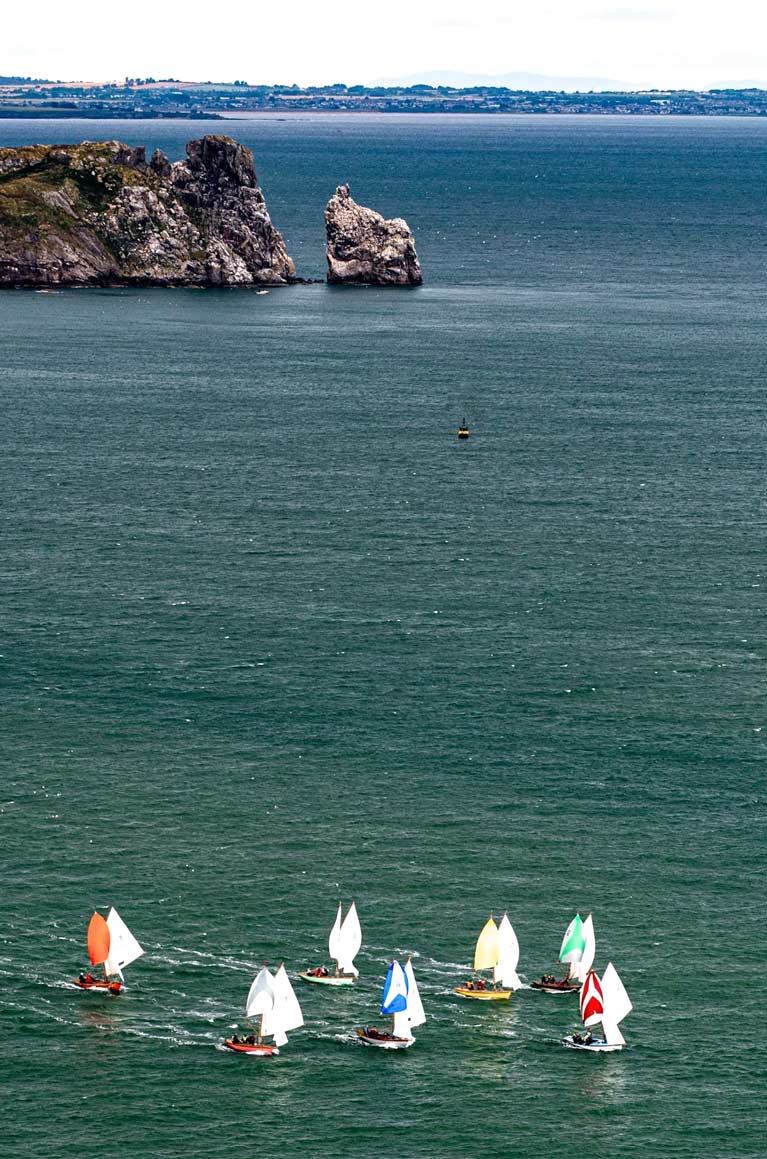 Still racing where they’ve been racing for 121 years – the Howth 17s with Ireland’s Eye beyond. Photo: Tom Ryan
Still racing where they’ve been racing for 121 years – the Howth 17s with Ireland’s Eye beyond. Photo: Tom Ryan
Today's Crosshaven Traditional Sail pursuit race attracted all types of plus keelboats for a harbour pursuit race, just part of this weekend's line up of attractions in Cork Harbour this weekend.
Today's start, at 2pm off ‘the Grassy,’ is a traditional sail race starting point for generations of sailors.
Today's fixture, under Race Officer Hugh Cassidy was not just for wooden boats but GRP cruisers over a certain age too.
Leading the fleet here was the wooden-hulled Northele pictured below in our gallery of photos by Bob Bateman
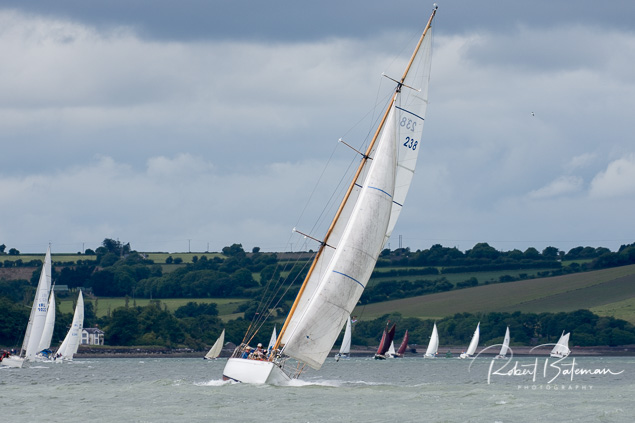
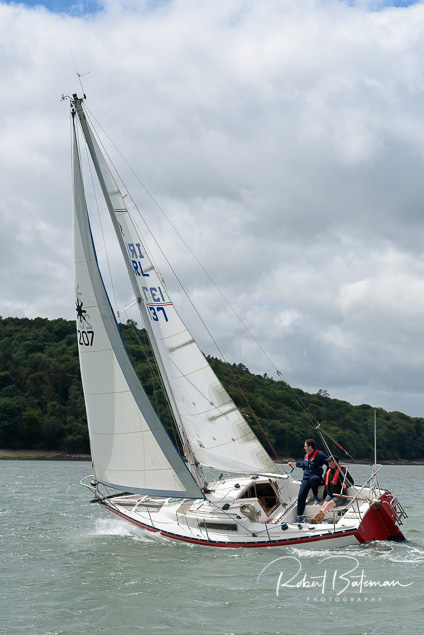

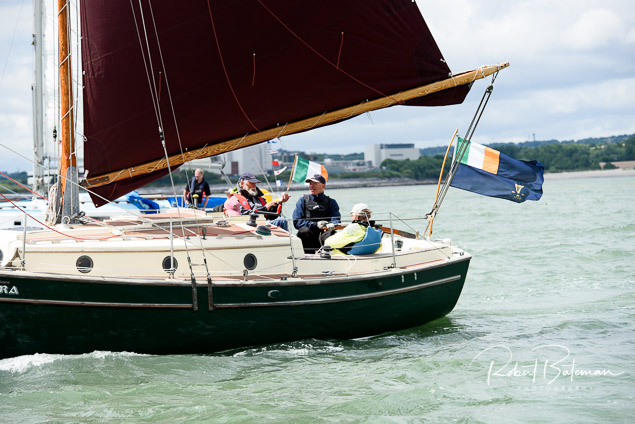

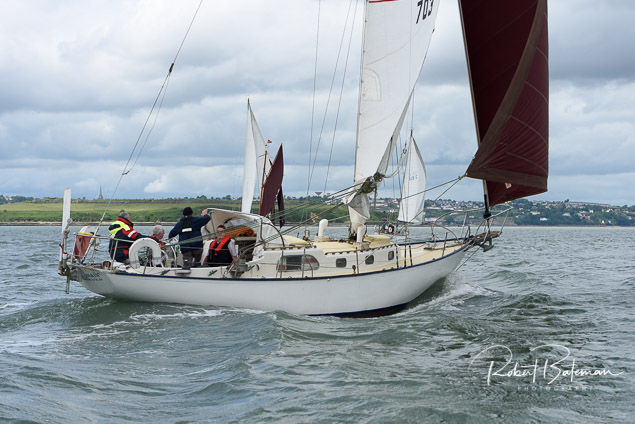
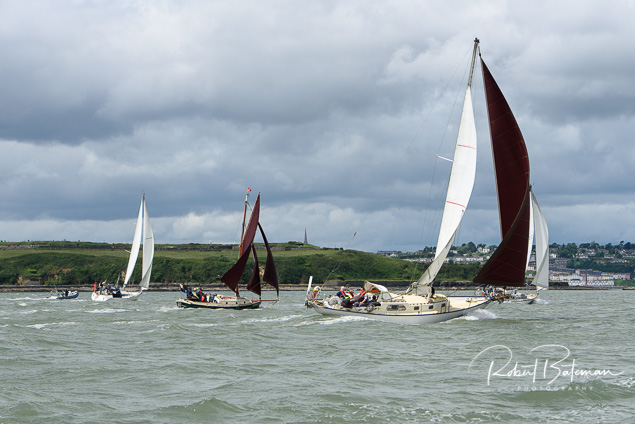
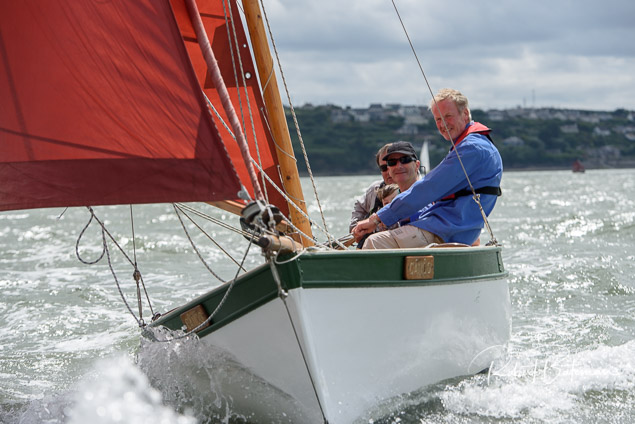
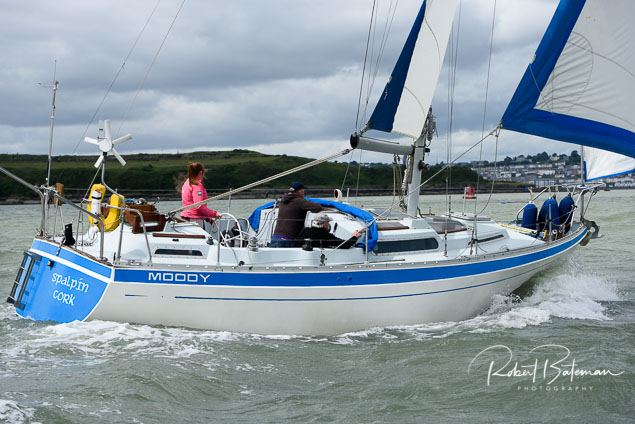
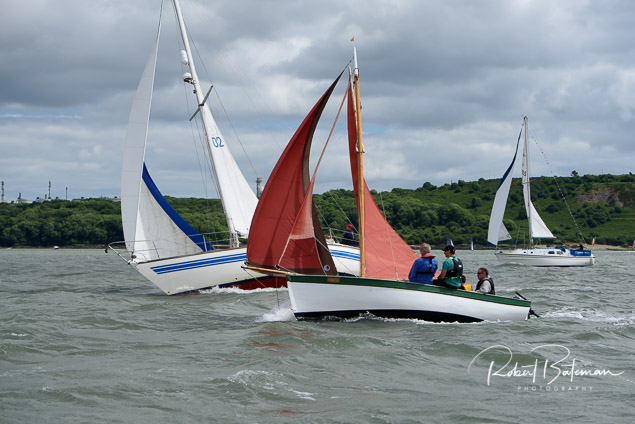
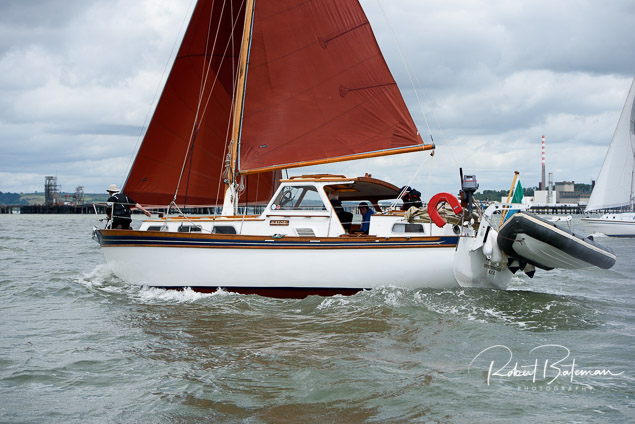
Ireland: No Country for New Boats?
In his poem Sailing to Byzantium (1928), William Butler Yeats immortalised the vision of Ireland as “no country for old men”. Expressed so well, the idea took hold and has been re-used internationally in novels and films, even if in Ireland itself some of our most influential decision makers – or perhaps more accurately decision-deferrers - were long past any official retirement age, making Ireland seem the ideal place for old men.
Yet for many ordinary folk, Ireland was certainly no country for old men – or women. Indeed, in the 1950s it had degenerated into somewhere that was no country for almost everyone. In today’s nearly-too-vibrant Ireland, it is difficult to visualize such a state of affairs. But it existed, even if now we live in a frenetic era in which Ireland seems to be playing a key role in the invention of new products in many areas of research and manufacture, with regular access to something fresh and completely new regarded as a birthright, whether we like it or not.
But surely we all like fresh and new products? Well, maybe in some areas of life we do. But in sailing, we really do seem to be in a place which is no country for new boats. We’ve an almost unhealthy veneration for old, traditional and classic craft. And if we accept that no-one is a hypocrite in their pleasures, then that’s the way it genuinely is. W M Nixon reflects on a central aspect of Irish sailing.
Originally, this was going to be a piece on how to cope with the enthusiasm of the incoming administrators of the Volvo Dun Laoghaire Regatta for the success, in 2017’s event, of the newly-introduced Classics and Traditional Class racing for the Kingstown 200 Trophy to celebrate the Bicentenary of the harbour.
 Boats of all kinds at the end of the day’s racing in the Volvo Dun Laoghaire Regatta 2017, with the engine-less classic Myfanwy on tow between cruiser-racers in the foreground, and Mermaids and Flying Fifteens beyond. Photo: W M Nixon
Boats of all kinds at the end of the day’s racing in the Volvo Dun Laoghaire Regatta 2017, with the engine-less classic Myfanwy on tow between cruiser-racers in the foreground, and Mermaids and Flying Fifteens beyond. Photo: W M Nixon
 “Sundry boats” – the slip at the NYC with Flying Fifteens, a Wayfarer, International 420s, a classic Royal Anglesey Fife OD, and cruiser-racers beyond Photo: W M Nixon
“Sundry boats” – the slip at the NYC with Flying Fifteens, a Wayfarer, International 420s, a classic Royal Anglesey Fife OD, and cruiser-racers beyond Photo: W M Nixon
 Somehow there was a way through for everyone, but patience was required. Photo: W M Nixon
Somehow there was a way through for everyone, but patience was required. Photo: W M Nixon
After the conclusion of VDLR 2017, in his first statement as the new Regatta Chairman, Don O’Dowd expressed the hope that the Golden Oldies – berthed in their special area off the National Yacht Club and highly visible to other competitors and the public alike – would become a regular feature in future stagings of the mighty biennial urban sailfest.
That caused a certain intake of breath here in SailSat Towers. We were peripherally involved in hunting down some of the more exotic and remotely-located classics, and persuading them to come to Dun Laoghaire for early July 2017. But it was done with a certain dogged enthusiasm, for we were reassured that this would be a one-off, and the suggestion was that it wouldn’t be repeated in future years. That was fine by us, as it was all just about as easy as herding cats at a cross-roads.
Then, when it all got started, the weather was perfect, mostly summery southeast round to nor’west breezes, offshore winds for the most part. Thus that temporary long pontoon over towards the Carlisle Pier, which was the making of it all, remained well sheltered, yet it would have had to be vacated pronto if strong onshore nor’easters arrived.
 Ideally gentle conditions for a crowded event with in-harbour finishes – a Colleen and the 1894-vintage Peggy Bawn, to which owner Hal Sis had fitted a set of cotton sails originally preserved by longtime owner James McAsey. Photo: W M Nixon
Ideally gentle conditions for a crowded event with in-harbour finishes – a Colleen and the 1894-vintage Peggy Bawn, to which owner Hal Sis had fitted a set of cotton sails originally preserved by longtime owner James McAsey. Photo: W M Nixon
A crazy idea we’d come up with – back in the March 25th 2017 Afloat.ie, but we’d been plugging it before then – was that in the absence of any commercial shipping, there should be in-harbour finishes for selected classes as another part of the Kingstown 200 celebrations.
But decision-maker Con Murphy acted quicker than anyone expected. He made all keelboat finishes in the harbour - and on a short line at that - and it reached its apotheosis on the Saturday, when a summery south to southeast blew gentle and warm. The East Pier became a peninsula which was a shore part of the course, as a weather mark well into Sandycove/Scotsmans Bay brought a very mixed fleet together for the run down to the end of the East Pier, then they’d to tack up the harbour to the finish in towards the National YC, and the regatta atmosphere was total.
Yet had there been foul onshore weather, this scenario would have been impossible, even if racing of some sort could have been arranged. So in looking back at the experience with the Kingstown 200 Classics, there’s an impulse to say that we were lucky, we mightn’t be so lucky in 2019, so let’s make it a one-off, celebrate what was achieved, and leave it at that. After all, a Bicentenary only occurs just the once.
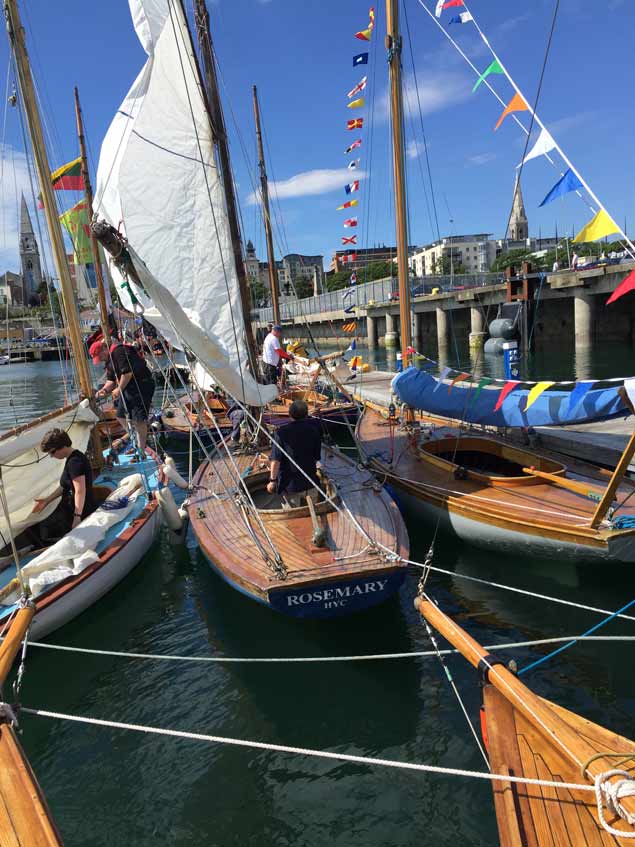 Anarchists from across the bay – Howth Seventeens (founded 1898) at the Classics Pontoon in Dun Laoghaire. Photo: Ian Malcolm
Anarchists from across the bay – Howth Seventeens (founded 1898) at the Classics Pontoon in Dun Laoghaire. Photo: Ian Malcolm
But now there are those from elsewhere who say that if they’d only known how good it was going to be, then they’d have come too. Yet perhaps most tellingly of all, there was the response from people doing the regatta in modern boats. Despite regularly sailing in the place, they hadn’t been fully aware of Dun Laoghaire’s extraordinary sailing history, and a heritage which would have been almost lost were it not for the Water Wags.
They happily now go from strength to strength, with a good chance that next Wednesday evening’s racing for the Captain’s Prizes (Hal Sisk is current captain) will see the turnout top the 30 mark for the first time since the “new” Wag design was introduced in 1900.
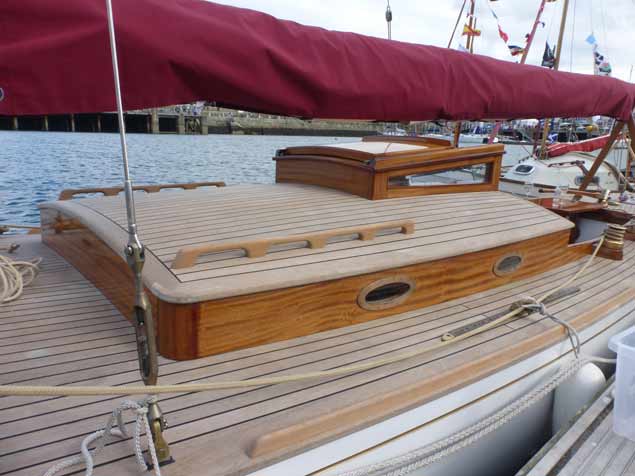 The re-born Dublin Bay 24 Periwinkle had some of the finest woodwork we’ve ever seen. Photo: W M Nixon
The re-born Dublin Bay 24 Periwinkle had some of the finest woodwork we’ve ever seen. Photo: W M Nixon
And back at Kingstown 200 in July, the restored Dublin Bay 24 Periwinkle turned up to wow everyone, and now there’s a fairly reliable whisper that a re-born version of the Dublin Bay 21s will appear next year. As for the assorted classics and traditional boats which did appear in 2017, seeing them as a little fleet had an impressive effect, and any increase in numbers will improve only improve that impression.
So old boats – and the more classic the better – are all the rage. And it’s not just limited to wooden boats. This week in Afloat.ie, it seemed perfectly normal that former Olympic sailor and four times Irish Helmsmans Champion Mark Mansfield of Cork should be writing very informatively and with enthusiasm about the classic Half Tonners at Kinsale. The great man is undoubtedly very into this class. Yet what he has been doing is writing about how you might best optimise the racing in boats which are thirty years old and more, and all of them from a former development class in which the newest boats were generally the fastest.
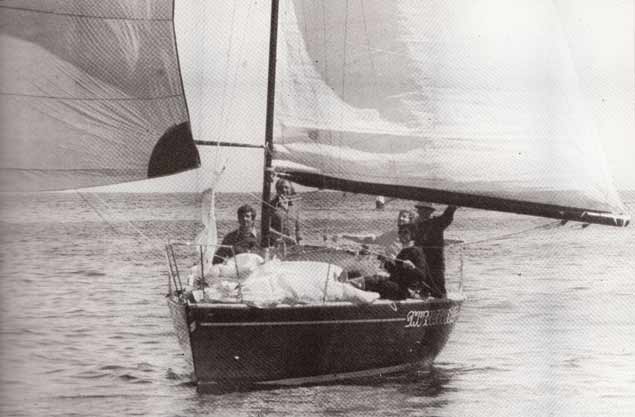 Swuzzlebubble in Bruce Lyster’s ownership in 1980, coming in to the finish of the Pwllheli to Howth race to win, and win the Irish Sea ORA Championship too, with Bruce Lyster (left) Robert dix on helm and Drewry Pearson and Des Cummins on right. Photo: W M Nixon
Swuzzlebubble in Bruce Lyster’s ownership in 1980, coming in to the finish of the Pwllheli to Howth race to win, and win the Irish Sea ORA Championship too, with Bruce Lyster (left) Robert dix on helm and Drewry Pearson and Des Cummins on right. Photo: W M Nixon
For anyone who would deny the Half Tonners classic status, I would defy you not to look at the gloriously individualistic and all-conquering Swuzzlebbble, and not be moved. I fell for her when Bruce Lyster first brought her to Ireland in the late 1970s. Since then, there has been the fairy story of how she was saved when just about to be dumped on a landfill in Greece. And now she is faced with having to get her rating down by 0.25 points if she is to stay within the proposed new Half Tonner rating band.
 The restored Swuzzlebubble at Kinsale. Photo: Robert Bateman
The restored Swuzzlebubble at Kinsale. Photo: Robert Bateman
Let’s hope it is an Irish owner who takes on this worthy challenge. But involvement at this level is not for the financially-challenged. Yet in looking at today’s Irish racing fleet of all sizes, the abiding impression is of a lack of totally new boats. The wounds of the financial crash have not yet full healed, and they may never heal in some cases. But there’s no doubting the fact that we’ve become very adept at sniffing out deals in second-hand boats, and with the huge slightly-used boat cornucopias so accessible in the south of England and France, it’s a happy hunting ground.
Thus of the current Queens of the Fleet in Dublin Bay, the thriving J/109 Class, only one or at most two were bought new. Before that, second-hand boats were the case with the rapid expansion of the Sigma 33 class. And across the bay and beyond the headland in Howth, the J/80 class continues to strengthen thanks to a ready second-hand supply which always grows towards Autumn, for simply keeping a boat in the main French and English sailing centres through the winter months can be one very expensive little hobby.
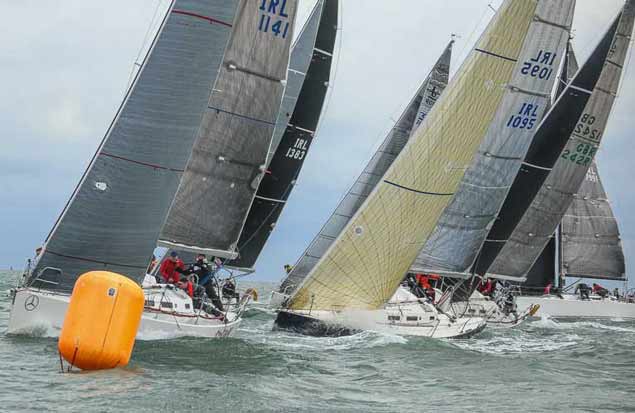 The J/109 Class in Dublin Bay Photo: Afloat.ie
The J/109 Class in Dublin Bay Photo: Afloat.ie
Of course, there’ll always be those who hanker after the unique feeling of a brand new boat, and who want to be at the cutting edge of development. But with Dublin Bay and Cork Harbour’s special combination of a reasonably affluent population within easy reach of good racing waters, there’s great value to be had either in acceptance of the limitations imposed by the One-Design discipline, or the patient optimising of an older boat to maximize her rating advantage for handicap racing.
The problem is that as the years pass and the second-hand boats coming on stream for modification possibilities become more technically advanced in their construction, we move from the world of the skilled amateur to the competent and much-in-demand professional. Thus the less affluent boat owners with some DIY capabilities find their options becoming more limited, and they seek an outlet for their talents and limited resources in older craft with comprehensible technologies.
 The 1895 Manx longliner Master Frank – bought derelict for £1, and self-restored by Joe Pennington And some are attracted to very old craft indeed, and often for historical reasons. Thus although in Dun Laoghaire we were bowled over by the sheer quality of the re-born DB 24 Periwinkle, there was no doubting it was a professional job of the highest calibre. So at a human level, it was much easier to be attracted to Joe Pennington’s restored 1895 Manx longliner Master Frank, for he restored her himself after buying her from the dithering Isle of Man government for £1 after an impassioned plea – while still wearing his working clothes as a carpenter – from the floor of the House of Keys in Douglas.
The 1895 Manx longliner Master Frank – bought derelict for £1, and self-restored by Joe Pennington And some are attracted to very old craft indeed, and often for historical reasons. Thus although in Dun Laoghaire we were bowled over by the sheer quality of the re-born DB 24 Periwinkle, there was no doubting it was a professional job of the highest calibre. So at a human level, it was much easier to be attracted to Joe Pennington’s restored 1895 Manx longliner Master Frank, for he restored her himself after buying her from the dithering Isle of Man government for £1 after an impassioned plea – while still wearing his working clothes as a carpenter – from the floor of the House of Keys in Douglas.
Then there was another star of the show, Rob Mason’s 1897-built Myfanwy from Milford Haven, self-restored and a very timely reminder in Dublin Bay of the largely-forgotten Liverpool naval architect Alexander Richardson, who was the toast of Kingstown Harbour back in 1884 when he created the design for John Jameson’s all-conquering cutter Irex.
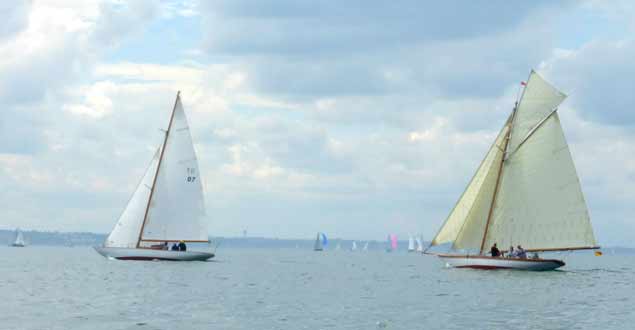 The originally-1947 DB 24 Periwinkle, with the 1897 Myfanwy giving her a run for her money. Photo: W M Nixon
The originally-1947 DB 24 Periwinkle, with the 1897 Myfanwy giving her a run for her money. Photo: W M Nixon
You feel you’re in touch with a deeper reality when you’re in the company of guys who have done their own major restorations and maintenance jobs, and one of my most memorable evenings was at the Peel Traditional Boat Festival in the Isle of Man a couple of years ago, when the mood was vibrant with the presence of Joe Pennington, Dickie Gomes, and Adrian Spence, who between them kept characterful boats of age total 361 years merrily sailing the seas.
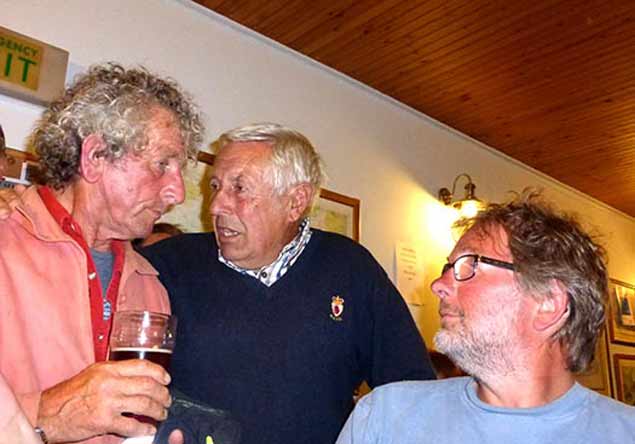 Joe Pennington, Dickie Gomes and Adrian Spence in the Isle of Man a couple of years ago, and full of opinions. At the time, the total combined age of their three boats was 361 years, Photo: W M Nixon
Joe Pennington, Dickie Gomes and Adrian Spence in the Isle of Man a couple of years ago, and full of opinions. At the time, the total combined age of their three boats was 361 years, Photo: W M Nixon
As a boat bodger of decades of experience, I can usually trade horror stories with the best of them, and indeed have shared some special moments – I was once hurled right across a shed in company with Dickie Gomes one winter’s night, when we were trying to fit a replacement plank in round the curve of the counter in Ainmara, and the replacement plank – of vintage salvaged pitchpine to match the timber in the boat – decided it preferred its lifelong straight shape.
The same can-do approach was evident in Rob Mason of Myfanwy. After the article about his mostly single-handed restoration of her appeared in Classic Boat magazine, we sent him off an email towards Christmas suggesting that as he was just across the channel, albeit in the long southeasterly direction in Milford Haven, he might like to bring Myfanwy to Dun Laoghaire.
 Invitation accepted from Australia…Myfanwy berthed inside Peggy Bawn in Dun Laoghaire, after owner Rob Mason had accepted the invitation to come with persuasion from his son Max in Australia. Photo: W M Nixon
Invitation accepted from Australia…Myfanwy berthed inside Peggy Bawn in Dun Laoghaire, after owner Rob Mason had accepted the invitation to come with persuasion from his son Max in Australia. Photo: W M Nixon
The email found him in Australia on holiday with his son Max, and when Max heard about it, he said he’d come home for a holiday to race Myfanwy on Dublin Bay for the Kingstown 200. So with mates Andy Whitcher and Gus Stott, they brought Myfanwy across and sailed so fast with her that the Progressive ECHO system proved to be the Aggressive ECHO for the team from Milford haven. They ended racing with a handicap nearly as high as Periwinkle, which seemed absurd, as Periwinkle won overall yet Myfanwy seldom got near the podium.
It seemed to me to be rather a weird sort of hospitality to be extending to such a special visitors, but the Myfanwy lads weren’t in the least bit fazed by it, in fact they were having a ball. And in bantering with them on the club balcony, I got to talking with Rob about how, in some jobs with restoring boats, you have no option but to do some risky undertaking with an angle grinder, which in a confined space can become a lethal weapon.
I showed him a now-faint scar across my thumb, a scar which looked quite a mess when it was fresh, while the thumb didn’t really deserve to be still attached to the hand at all. But the great restorer of Myfanwy put me in my place. Rob simply hauled up his T-shirt, and there on his midriff was the unmistakable imprint of an angle-grinder, but now so neat it’s like a tattoo. These are the kind of people who keep the really interesting old boats going.
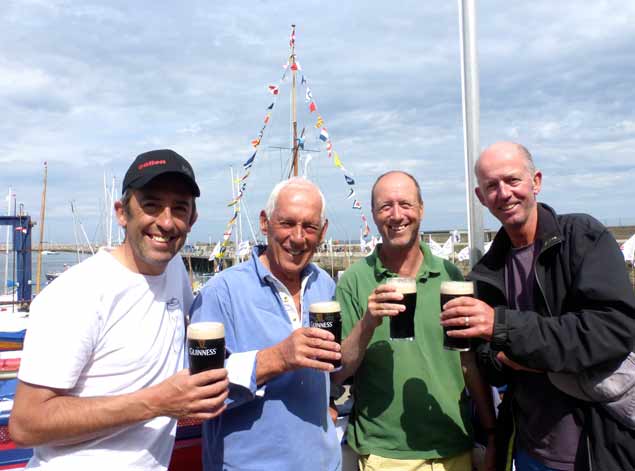 Classic people and classic celebration (left to right)– Max Mason, his father Rob Mason who restored Myfanwy, Andy Whitcher and Gus Stott. Photo: W M Nixon
Classic people and classic celebration (left to right)– Max Mason, his father Rob Mason who restored Myfanwy, Andy Whitcher and Gus Stott. Photo: W M Nixon
Crosshaven Traditional Sail Weekend Photos in Cork Harbour
Today's Crosshaven Traditional Sail pursuit race attracted all types of sailing dinghies from National 18s, Enterprises to Rankins plus vintage keelboats for a harbour pursuit race, just part of this weekend's line up of attractions for the Traditional Boat Festival in Cork Harbour. As Tom MacSweeney reported earlier, today's start, at 2pm off ‘the Grassy,’ is a traditional sail race starting point for generations of sailors.
Shooting from a local clinker–built punt, Afloat photographer Bob Bateman was there to capture the unique fleet on a lovely afternoon in Cork Harbour.

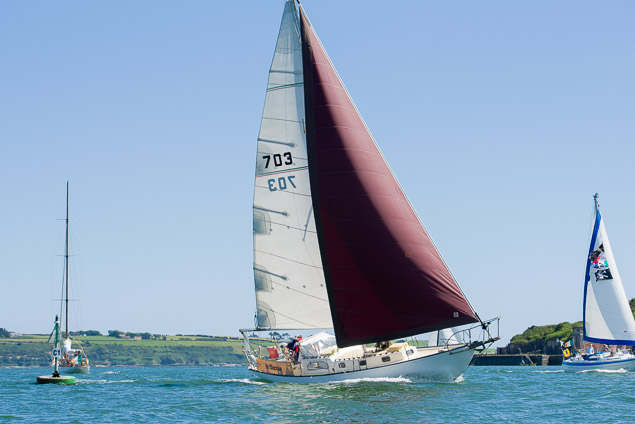
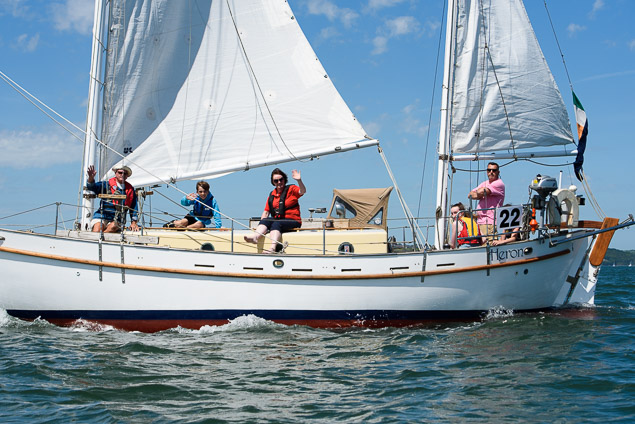

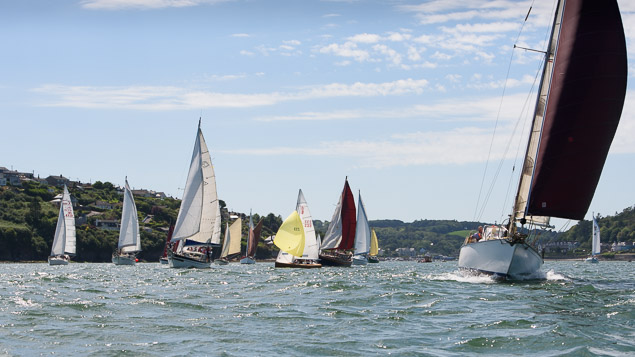
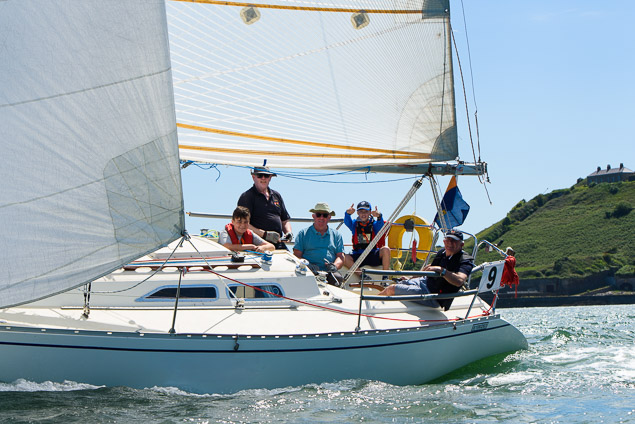

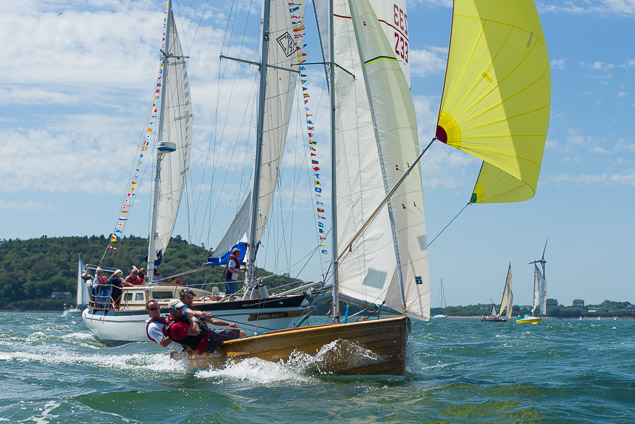

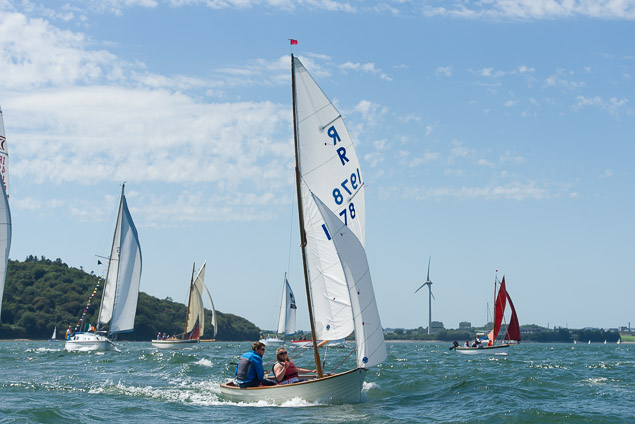
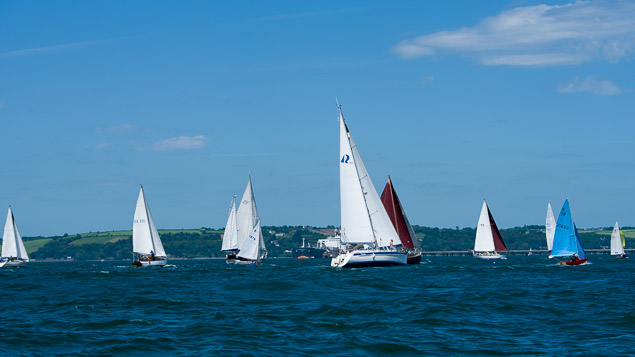
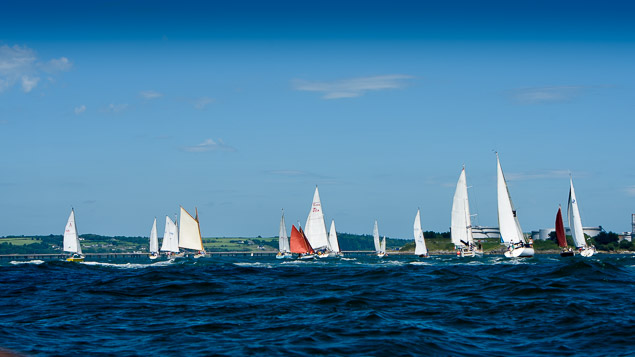

Traditional Boats in Crosshaven This Weekend
Preserving traditional boats is very important, using them even more so and racing them a sight to behold writes Tom MacSweeney. All can be seen this weekend at Crosshaven in Cork Harbour where vintage boats of all types, shapes and sizes will gather for the annual Crosshaven Traditional Sail.
It begins this evening with the official opening at the Oar Bar in the village at 7.30 p.m. Boats will be at the Hugh Coveney Pier where Skippers will be briefed at 1230 on Saturday about the first race, scheduled to start at 2 pm off ‘the Grassy,’ traditional sail race starting point for generations of sailors.
There is another race scheduled for Sunday, again at 2 p.m., with a Parade of Sail afterwards.
What I particularly like about the traditional boat people is their ‘relaxed’ approach to sailing. They make it a strong social occasion when they gather. They are a magnificent sight racing in the harbour, boats of many kinds, and sails of several colours.
There will also be a ‘Pirates Trail’ and a ‘Seafood Trail’ to be followed.
“Our purpose is to make sailing enjoyable and show how valuable it is for our maritime heritage and culture not only to preserve the traditional boats, but to keep them in use. That’s the purpose of a boat, to use and enjoy it,” the organisers say. There will be prizes for the racing, for the best dressed boat, best dressed crew, oldest and youngest crew and the boat which travels further to reach Crosshaven.
Traditional Boats of Peel, Isle of Man Do The Business
The Peel Traditional Boat Weekend at the hospitable port on the west coast of the Isle of Man has been developing steadily since its inception in 1991. Located in the middle of the Irish Sea, the Peel gathering has become a magnet for boat enthusiasts of all kinds from Ireland, Wales, England and Scotland. W M Nixon sampled it for the first time in August 2013, and found that it deserves its hospitable reputation.
#peel – Cruising around the Isle of Man is dictated by its extraordinary tides. We may not be talking of the exceptional ranges of the Bay of Fundy, but you're right up with the North Coast of Brittany in the island's huge rise and fall. As for the ports, there are only two which have been fitted with automatic gate flaps that retain enough water in their harbours for civilised berthing at marina pontoons when the tide has receded.
These are the island's capital of Douglas on the east coast, and the ancient fishing stronghold of Peel on the west. At other ports such as Ramsey, Laxey and Castletown, you have to be prepared to dry out alongside. There are anchorages of sorts available at the main sailing centre of Port St Mary on the south coast (where it is also possible to lie afloat alongside at low water, but it's an unbelievably long way down), at Derbyhaven in behind the island's southeast corner of Langness, and at Port Erin towards the southwest corner, but they don't really provide the restful berths which cruising folk hope to find at the end of a day's sail.
We'd hoped to round out our two year sailing celebration of the centenary of Dickie Gomes' 36ft yawl J B Kearney Ainmara by an easygoing circuit cruise of the Isle of Man (the old girl won the Round Isle of Man Race in 1964, when she was but a stripling of fifty-two summers), and conclude it with participation in the Peel Traditional Boat Weekend 2013, in its turn the concluding event in the Irish Sea of the Golden Jubilee celebrations of the Old Gaffers Association, in which we'd already been much involved in Dublin and Belfast. But it was a programme which just couldn't be made to integrate.

While the Isle of Man would be attractive to cruise round if the harbours at Ramsey, Castletown and Port St Mary provided floating berths, the fact that only Peel and Douglas have marinas enclosed within gate flaps makes it very tempting to keep your boat at one of these two ports, and see the rest of the island by other means.
Though I haven't seen it stated in any relevant cruising directions (perhaps because it's so bleeding obvious), the sensible time for a three or four day cruise around the Isle of Man is when high water is morning and evening. That means you can arrive off your chosen port for the night at a civilised hour, and go in immediately. Even if you've had to dry out overnight, you can still depart at your leisure in the morning on the new tide, and though you may have to push tidal streams to the next port, the tides are much smaller when high water is morning and evening rather than noon and midnight, so you have a chance of overcoming any adverse streams. Then too, the weaker tide means there's less likelihood of rough water, which in certain areas of the Isle of Man is something of a speciality.
But the format of the Peel Traditional Boat Weekend scuppered this fine plan of a leisurely island circuit. The Weekend is staged when high water is pushing towards lunchtime, as the waterborne highlights of what is really a five day boatfest are Parades of Sail on the Friday and the Sunday. On those days, everyone is expected to head seawards just as soon as the automatic gate flap goes down, then they tear around on the Irish Sea for a couple of hours with all sail set, showing off big time, and then they scuttle back into port before the gate comes up again.
It works very well, but it means that you're totally Peel-focused for the berthing of your boat while the festival is in full swing. So we reckoned the only solution was to give in gracefully. Ainmara secured a marina berth handily off the Creek Inn, and there we were every night from Wednesday August 7th until Sunday August 11th, absorbing Manx culture by the bucket-load, and taking on board nautical ideas, rig designs, and boat layouts of every imaginable type, plus a few totally unimaginable as well.

Ainmara manoeuvring into her convenient berth in Peel Marina off the Creek Inn. Photo: W M Nixon
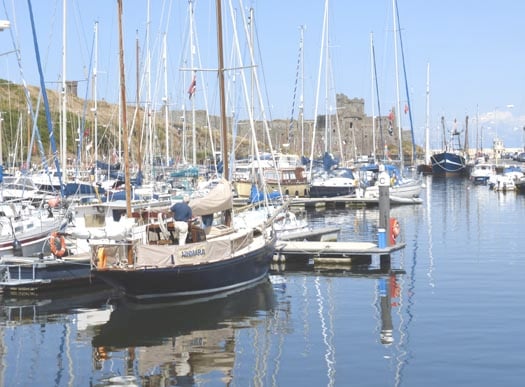
High summer in the Isle of Man. Looking seaward down the inner harbour at Peel towards the castle. Photo: W M Nixon
It was the ideal scenario for a plague-like outbreak of harbour rot, but as already reported here on August 24th, we made an immediate point of visiting the world's oldest yacht, at her abode in the characterful old port of Castletown before contemplating anything else. And then between the jig and the reels we saw a lot of this fascinating island by many different means of transport, only drawing the line at the ancient tram which runs between Douglas and Ramsey, because even for the most easy-going cruising man, it is just too slow.
Perhaps it's there to offset a central part of Manx culture, the TT motorcycle jamboree. The tram may well be a deliberate reminder of the slow and safe life, but the TT is all about fast and dangerous, and it's almost a religious cult. With the quaint little winding roads, the Isle of Man is probably the only place in the world where the tourism authorities will object if the road engineers want to straighten out a particularly dangerous corner.
One of our ship's complement of three, Brian Law, is a mad keen biker, so he really was in seventh heaven, but we kept him grounded with more sedate ways of travel such as the little old very smoky narrow gauge steam railway which runs from Douglas eventually to Port Erin - and don't forget to start your journey with the fireman's breakfast off a shovel in Douglas station.
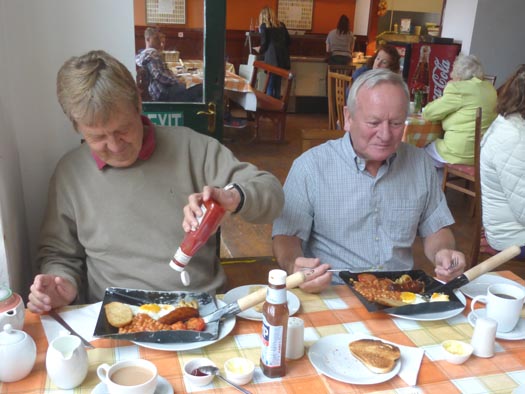
The only way to start the journey – the Fireman's Breakfast in Douglas Station, served on a shovel. Photo: W M Nixon
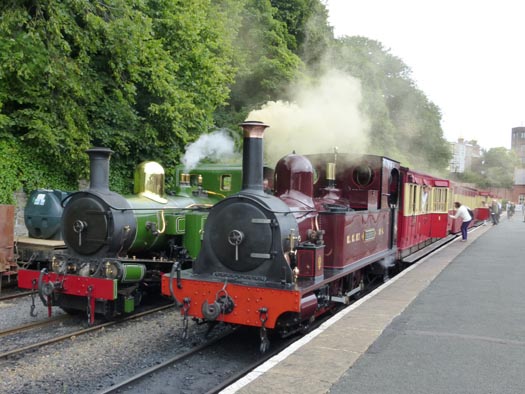
The Peel to Port Erin Express. Needless to say, each vintage compartment had a No Smoking sign. Photo: W M Nixon
But having done the island from end to end, the crew of Ainmara would like it to be known that the best way to cruise the Isle of Man is up front on top of a double-decker bus. Much of the island scenery is a sort of miniaturised Ireland or Scotland, so at first it seems completely bizarre that urban double-deckers run on many of the routes. And up top, it has to be admitted that at times the old bus gets a mighty wallop from a tree branch. But the views are marvellous, you get to meet a fascinating array of the locals, the bus will take you scenically to an extraordinary variety of towns and villages, and at day's end you return to Peel, the most characterful place of all, and there sits your boat serenely off the inn, and the party just getting going. It's cruising perfection.
And for anyone into traditional or classic or just interesting boats, Peel is paradise. We'd got the flavour of it as we'd arrived in the sunshine of a perfect summer's day on the Wednesday, going through the narrow entrance with Mike Clark's Manx nobby White Heather – traditionally rigged with huge lug mainsail – to starboard, while to port beside the harbour office was the superbly restored varnished Ray Hunt-designed 57ft Drumbeat, originally built for Max Aitken with twin centreboards – one for each tack – back in 1957, and newly arrived as an Isle of Man resident after her second total restoration.

Mike Clark's restored Manx nobby White Heather sets the classic lug rig.

The superstar of 1957. The restored Drumbeat with her varnished hull is a new resident of the Isle of Man. This view is looking seaward towards the Outer Breakwater over the footbridge and gate flap at the entrance to Peel Inner Harbour with its marina. Photo: W M Nixon

Peel's marina has revitalised this former fishing port. Photo: W M Nixon
Peel has always had something special, and since it got its gate flap in 2005 and the 124-berth marina three years later, the harbour area has been on the up and up, and the maritime community spirit in the town is a real tonic. We got our first taste of it that night in the Peel Sailing and Cruising Club where there was a merry buzz and a sense of anticipation with greetings for many old friends already there, and more on the way with the clubhouse affording a fine view of the outer breakwater, above which the upper rigs of gaffers could be seen as they headed for port in the last of the evening light, providing an entertaining guessing game as to which boat would be revealed as they swept past the outer end.
In the morning the harbour was sunlit and lively with more boats which had come in on the midnight tide. We finalised our entry and found that as were to do our duty by making a holy show of ourselves during the Parades of Sail for the delectation of the public, our hosts in turn would feed and water us in port, with the makings of breakfast put aboard each morning, and a fine feed for all crews each night in the Masonic Hall, the only place in Peel big enough to cater for the crowd.
All this hospitality at the Peel Traditional Boat Weekend involved many people and several organizations with a raft of sponsors, so it was a bit difficult to keep track, but as the two days of sport afloat had their timing dictated by the opening of the gate-flap, it was literally a case of going with the flow and enjoying yourself.
The basics of the weekend's administration were provided by Mike Clark of the traditional Manx Nobby White Heather and his PL 2013 team, but while they with their access to the Masonic Hall had the space for the crowd scenes, Andy Hall the Commodore of Peel S & Cr C and his many volunteers provided an additional key focal point in their fine clubhouse. So we'd all these delightful folk making a massive and very effective voluntary input to our enjoyment, and that was before we acknowledged the contribution of the top honchos of the various Old Gaffer Associations from all round the Irish Sea.

Mike Clark of White Heather heads up a remarkable squad of volunteers to make the Peel Festival a success. Photo: W M Nixon
Peel is a natural centre to draw in boats from Scotland, Ireland north and south, North Wales, and northwest England, so much so we had to stop ourselves thinking it was like a conference of Sub-Saharan African states, as the gathering was eventually to include Their Excellencies the Presidents or Senior Plenipotentiaries of Nioga, Dboga, Nwoga and Soga. More boats came in on every tide with more than 70 finally in the fleet, and as they wouldn't be able to get out across the gate-flap until late morning next day (Friday August 9th) for the first Parade of Sail, there was ample time in the sunshine to inspect the gathering in its glorious variety.
Stu Spence's 1875-vintage Pilot Cutter Madcap from Strangford Lough was in, recently back the Isles of Scilly where they'd renewed the rudder stock after breaking it west of Brittany, and steering themselves unaided by the cunning use of trailed buckets all the way to Scilly, where with considerable ingenuity they fixed the rudder. The crew for this remarkable feat included noted Isle of Man sailor Joe Pennington whose own restored Manx longliner Master Frank was another of the stars of Peel.
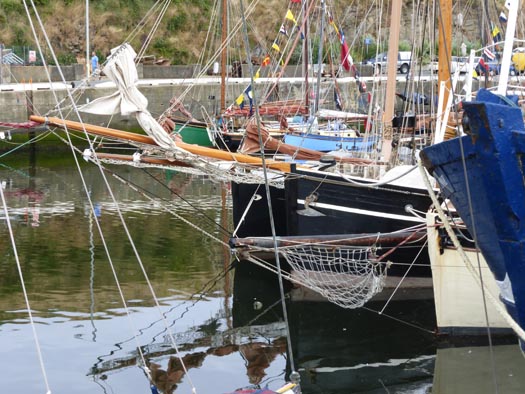
"Dock probes". Bowsprits were everywhere – these are on Mona, Vilma and (foreground) Madcap Photo: W M Nixon
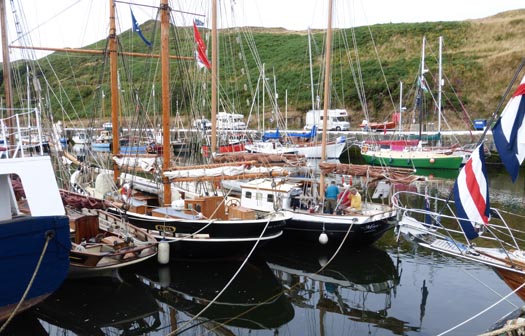
The sterns came in all shapes and sizes – these are (left to right) Madcap, Vilma and Mona Photo: W M Nixon
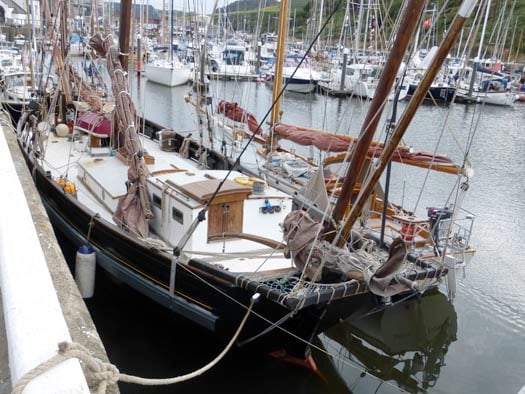
The Bisquine-rigged Peel Castle from West Cork, and outside her the Warington-Smyth cutter Dreva from North Wales. Photo: W M Nixon

We still await a photo which does justice to the West Cork-based Bisquine-rigged Peel Castle under sail (it would need to be in a lot of wind). Meanwhile, this one of her setting up her spars gives some idea of the eccentric rig which Graham Bailey has installed. Photo: W M Nixon
Ingenuity on a massive scale had also been involved in the creation of Graham Bailey's lugger Peel Castle from West Cork, which despite her name was originally a 50ft Penzance fishing boat built in Cornwall in 1929, but had been so named because Peel Castle was a familiar landmark for the roving Penzance fleet, and it is also the title of a much-loved fishermen's hymn. Though built as a motorized vessel, this fine vessel effectively had a sailing hull, thus when Graham bought her in 1999 he was acquiring a traditional sailing hull just as new as he could get. He spent nine years restoring and converting her at Oldcourt on the Ilen River, rigging her as an eye-catching French bisquine. With three masts in a fan configuration, she certainly looks unusual, but her sailing record speaks for itself, as she has cruised the length of the Mediterranean to Greece, and was in Peel in the latter stages of a three-month round Ireland cruise with extras which had already included a detailed cruise of the Hebrides and a passage out to St Kilda.
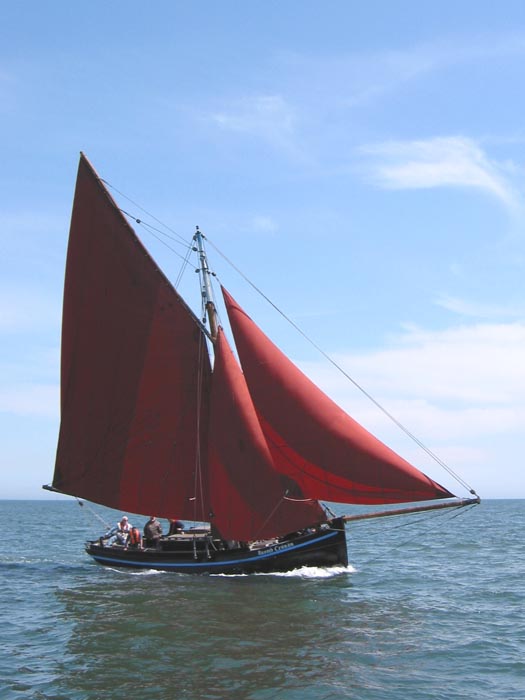
The Galway Hooker Naomh Cronan was built in Clondalkin, West Dublin, by a co-operative which still functions successfully after 15 years. Photo: W M Nixon

The Albert Strange yawl Emerald sailed south by Scottish owner Roger Clark was one of many smaller craft taking part in Peel 2013. Photo: Carol Laird
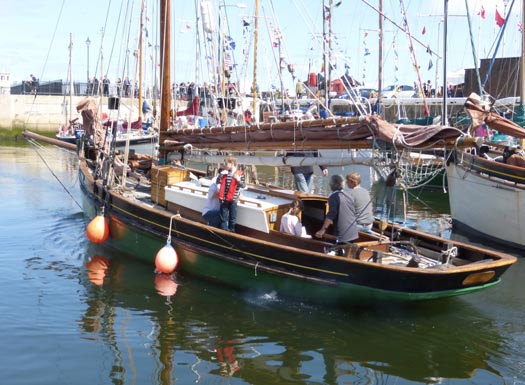
Joe Pennington's Manx longliner Master Frank is the sole survivor of a once numerous Ramsey-based sailing fishing fleet. Photo: W M Nixon
Irish traditional boats were flagshipped by the big Galway Hooker Naomh Cronan, which has been built and kept going for a remarkable 15 years by a co-operative based in Clondalkin in West Dublin, while the long story of Welsh slate schooners was represented by Scott Metcalfe's Vilma from the Menai Straits. She may have started life in 1934 as a ketch-rigged Danish sailing fishing boat, but when Scott and his wife Ruth restored the hull at their boatyard in Port Penrhyn on the Straits, they fitted her with a classic Welsh schooner rig, with the square sails aloft on the foremast mainly handled from deck. The hull certainly shows Vilma's Baltic origins but her rig, as we were to see when the Parade got going, is very much Welsh schooner, and apparently easy to handle, though that may have been the skill of the crew.

Vilma was one of the stars of the show. Photo: Carol Laird
Finally the gate-flap opened later than expected on the Friday morning, and those who were up for the Parade – not everyone by any means – went out onto a lively sea with the sun coming and going and a good breeze sweeping in from the west. Provided we didn't have to go to windward, Ainmara could carry full main, and so long as we kept reaching, she could carry jib tops'l too. So with Brian on the helm, she reached up and down in all her finery, and though we had to throw the outer tack a couple of miles out in a rumbly seaway each time we shaped up to parade back towards Peel, when nearing the shore on the inward track we asked our helmsman to tack as far up the outer harbour as he could at the inner turn in order to provide the smoothest possible water for elderly gentlemen hopping about the deck to clear sheets.

Zapping along – Ainmara at full speed as she shapes her course in towards Peel Castle and the circuit of the Outer Harbour. Photo: W M Nixon
Being a biker, Brian is an ace close quarters helmsman, and each time coming in he brought Ainmara right into the upper reaches of the outer harbour as though he expected to go straight on up the main street. Then a long elegant curving tack, and out we went again with everything setting to perfection before open water was reached, and the old girl outsailing everything else large and small, all great fun.
We'd more of the hospitality that evening with a substantial supper in the Masonic Hall and a great session in the sailing club with Adrian Spence and Joe Pennington in fine form as they detailed their experiences in getting the rudderless Madcap in to Hughtown from somewhere off Ushant, and then a blow-by-blow account of the re-installation of the re-built rudder.
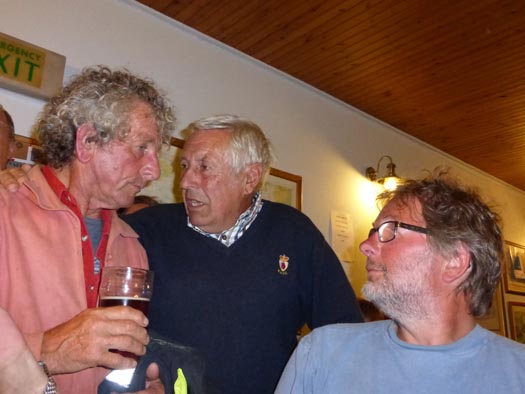
Everybody has a right to their opinion....Joe Pennington, Dickie Gomes and Adrian "Stu" Spence in conference in Peel S & Cr C. Photo: W M Nixon
The Peel people were as good as their word in putting the makings of breakfast on board each morning, but they had started gently enough with standard bacon and egg and the usual extras on the Friday. Then Saturday started the grown-up breakfasts, with a bag of magnificent Manx kippers placed into the cockpit. Our captain became the kipper skipper. We were pleasantly surprised at how much of a dab hand our master and commander was in cooking them lightly to perfection, and by the time we got back from the island, it was difficult to imagine starting the day any other way.
That Saturday (August 10th) was a sort of public interaction day, and included a "dirty boatbuilding" competition beside the harbour, with each team being given enough material to build a small boat – well, not so much a boat, more something that would just about float - then they were given a time limit to finish. The whistle blew to start, it blew again to signal time up, and the winners were the first team whose crewed boat managed to get across the harbour. They had all the teams they needed, though few enough old gaffer owners took part, as they reckoned most of their winters were spent like this, and they'd prefer to do just about anything else, while for Ainmara's crew, it was the day of the great steam train ride.
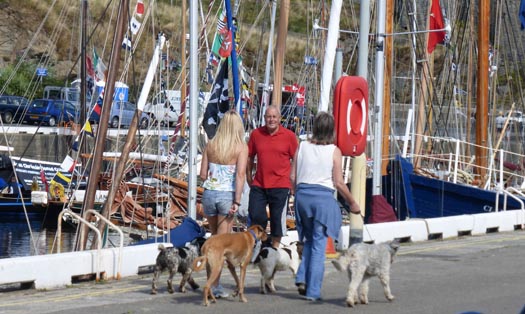
It may be the Peel Traditional Boat Weekend, but walkies are still expected. Photo: W M Nixon
Back in Peel for the Saturday night festivities, Andy Hall, Commodore of the Peel S & Cr C (which is twinned with Down Cr C) had told us not to eat ourselves silly early on, as the real feasting would take place in his club from 9.0 pm onwards. It was a masterwork of voluntary enthusiasm. His members threw themselves into preparing a mountain of queenies (the succulent Manx queen scallops) cooked six different ways, and a very eclectic clientele (for this seems to be one of the highlights of the Manx social calendar) threw themselves into a massive over-consumption in which all pretences at dining delicacy went by the board. We ate ourselves to a standstill with strangers now the best of friends, but it wasn't an exceedingly late night, for with a week's supply of protein taken aboard in one go, we'd to go back to the boat at a reasonably early hour to sleep it off.
It must have all been cooked to perfection, for there were no ill effects in the morning (Sunday August 11th) and we could breakfast off the skipper's kippers with relish. But while our guts were well settled, the weather was anything but. Though a passage home was a possible if rugged proposition for that Sunday with a fresh to strong sou'wester expected, strong west to nor'wester forecast for the Monday would have meant a dead beat, and no go at all for ancient craft.
We were all three on a three-line whip to be back by Monday night. So instead of taking part in Sunday's Parade of Sail, Ainmara returned across the Irish Sea while we could. Even if it did involve a demanding slug of a passage, it was a shrewd move, for anyone from the east cost of Ireland who stayed until Monday didn't get back until Tuesday.
It was a couple of weeks before news of the awards filtered through. Not surprisingly, both Vilma and Peel Castle received major trophies. But as we'd been a no show in the second Parade of Sail, it was a complete surprise that Ainmara had been awarded the Creek Inn Trophy for Best in Show for her one appearance on the Friday. It was the jib tops'l wot done it. All credit to Mike Sanderson of Sketrick Sails for making the old girl a very elegant set of threads. It was a sweet ending to two seasons of centenary celebration.
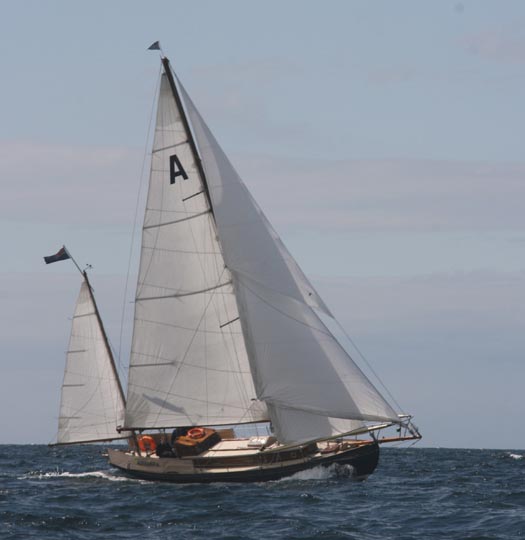
"It was the jib tops'l wot done it......" Ainmara in fine form, on her way to winning the Creek Inn Trophy for 'Best in Show'. Photo: Carol Laird



























